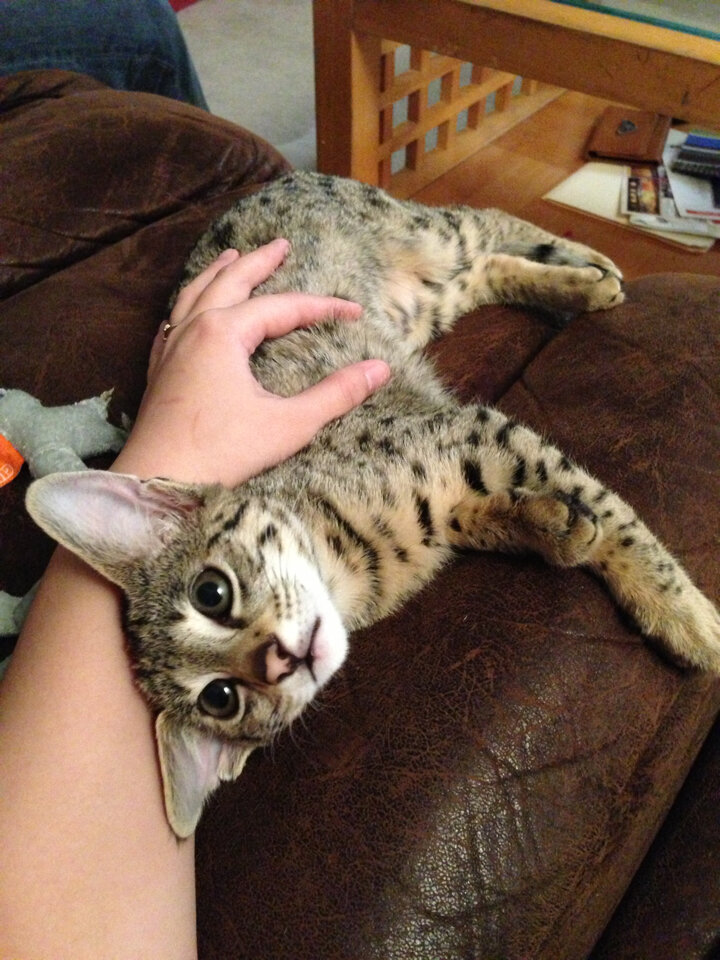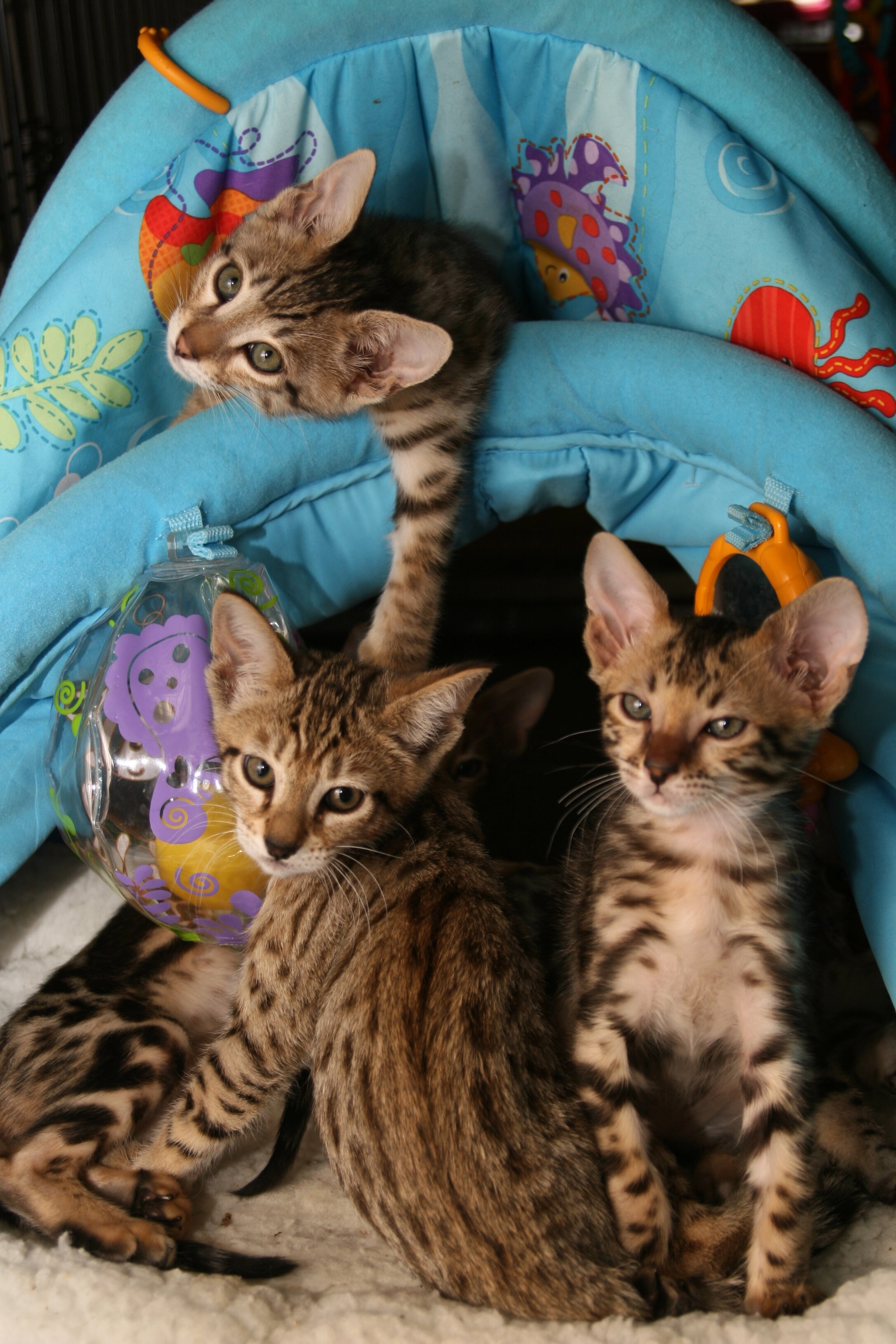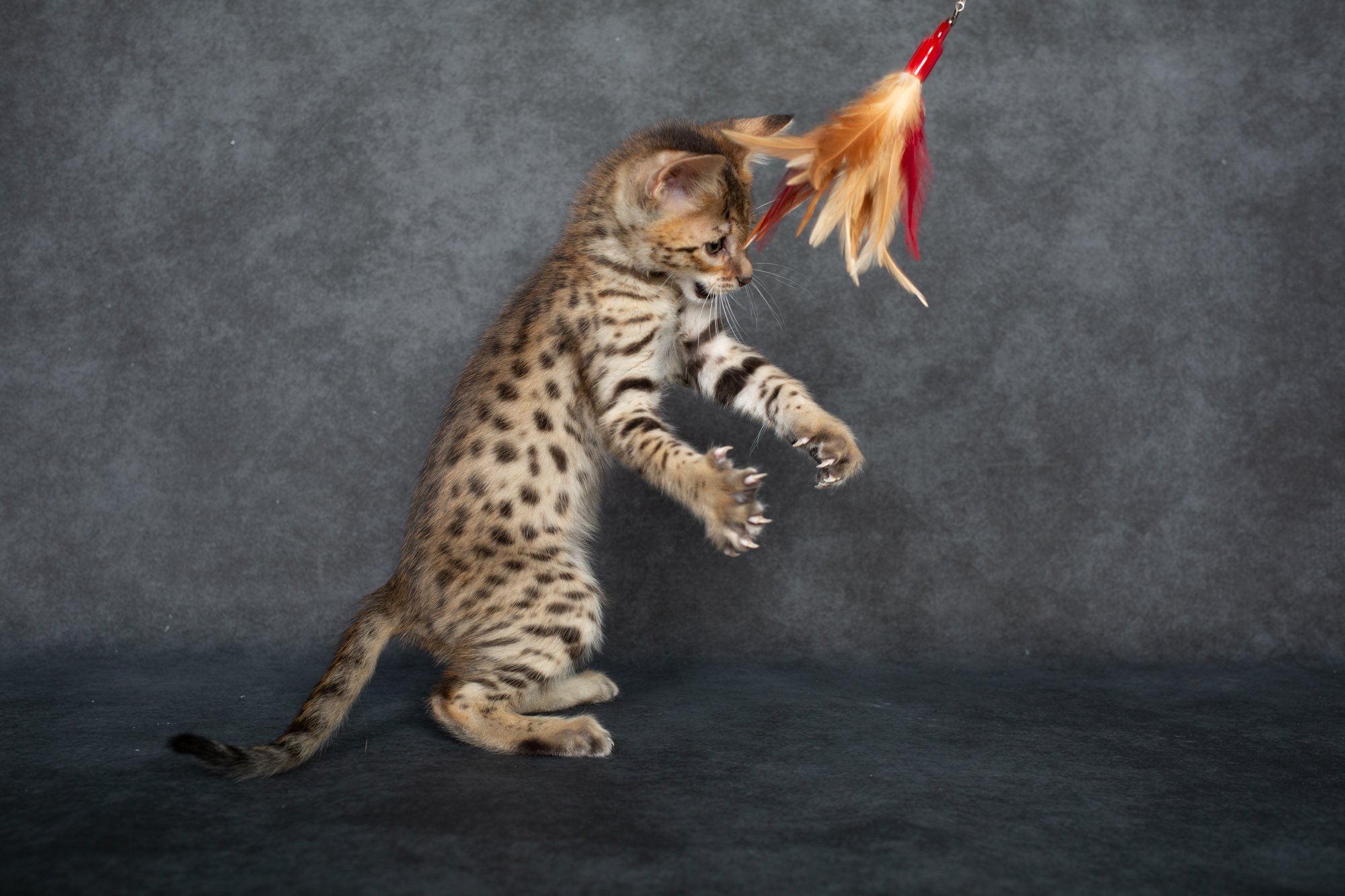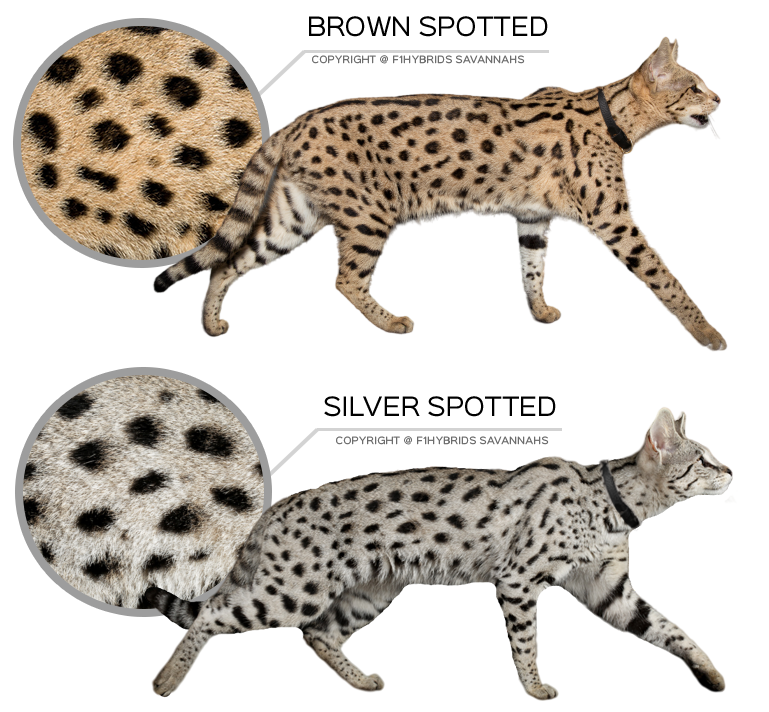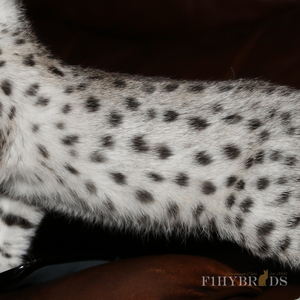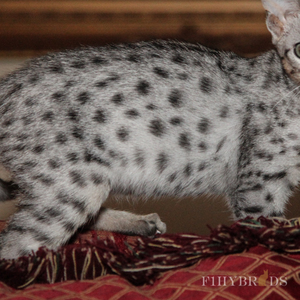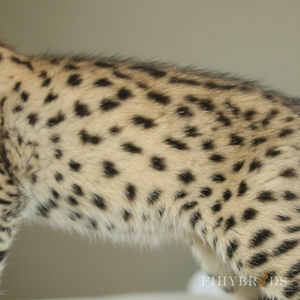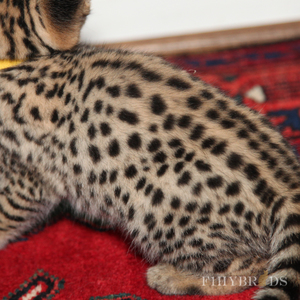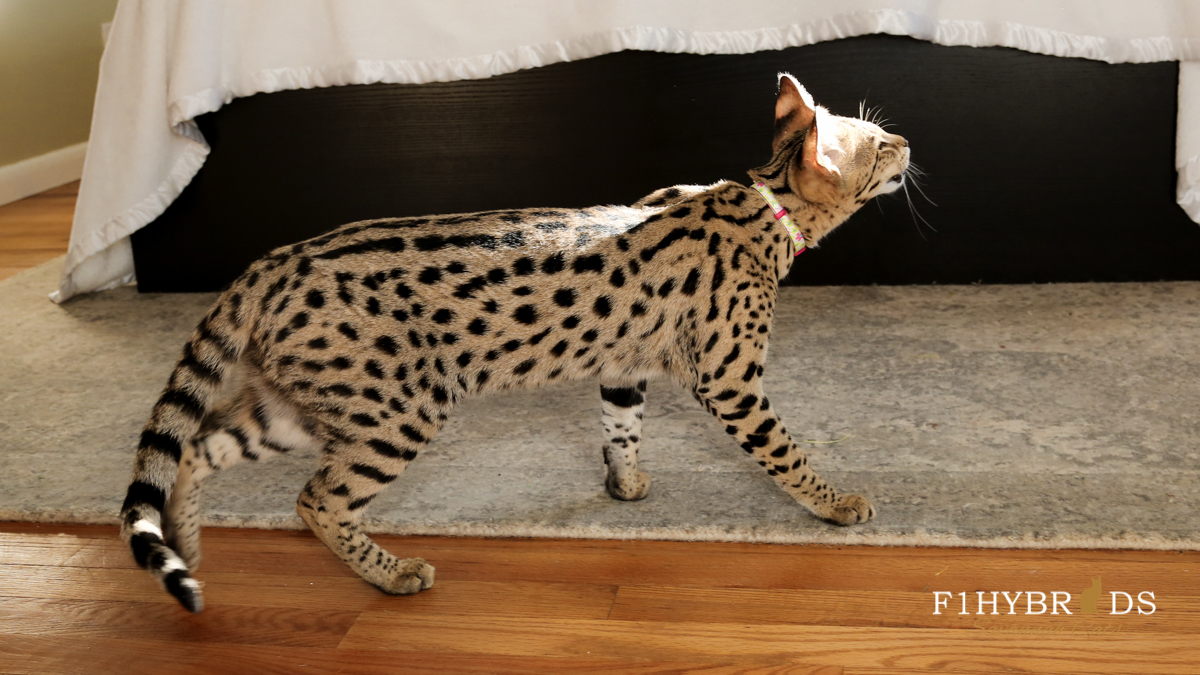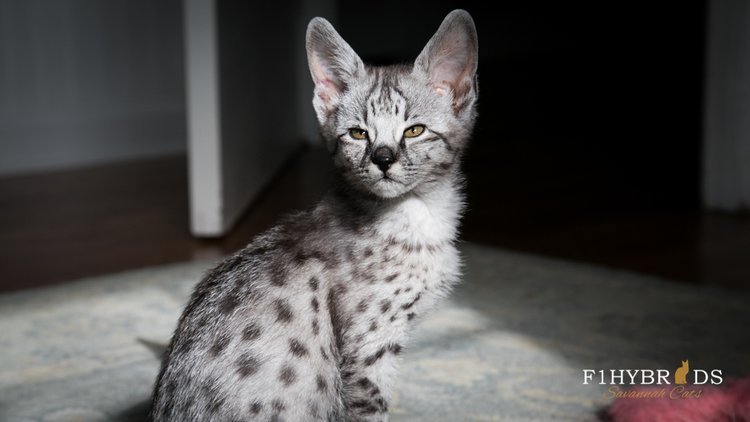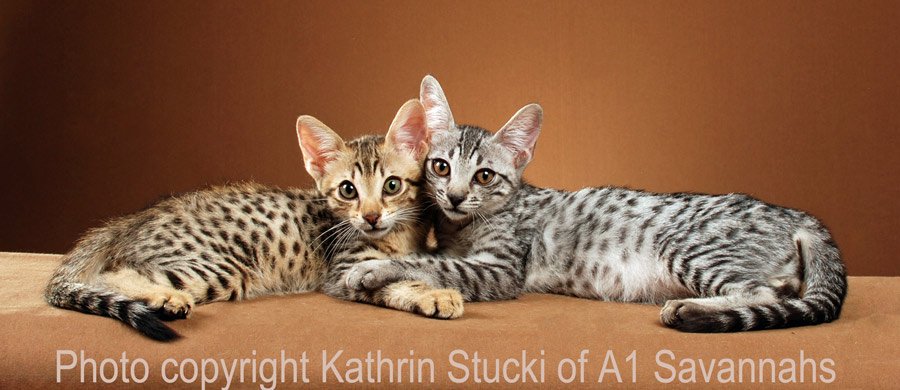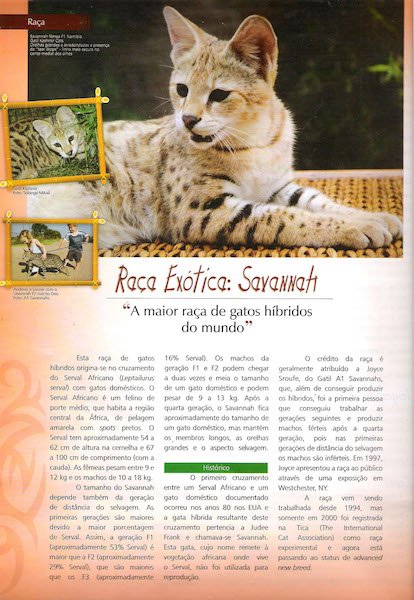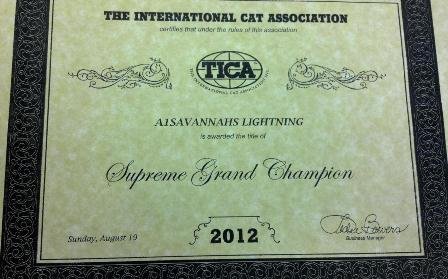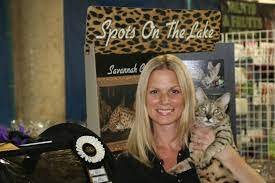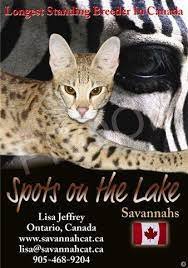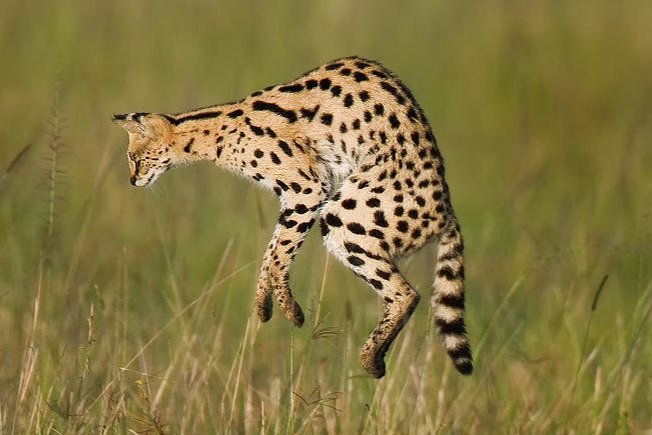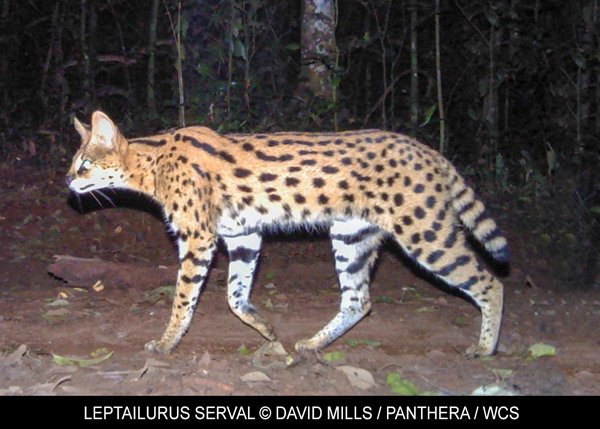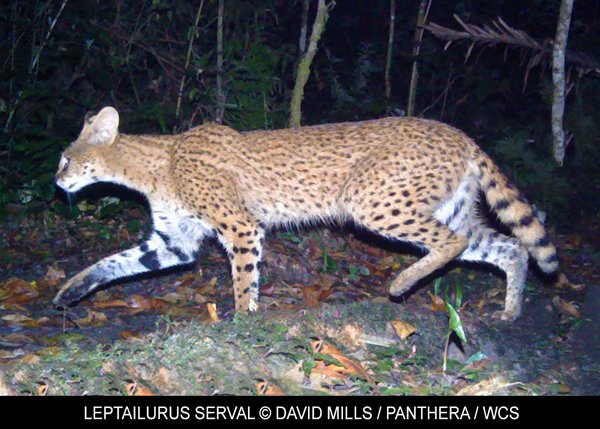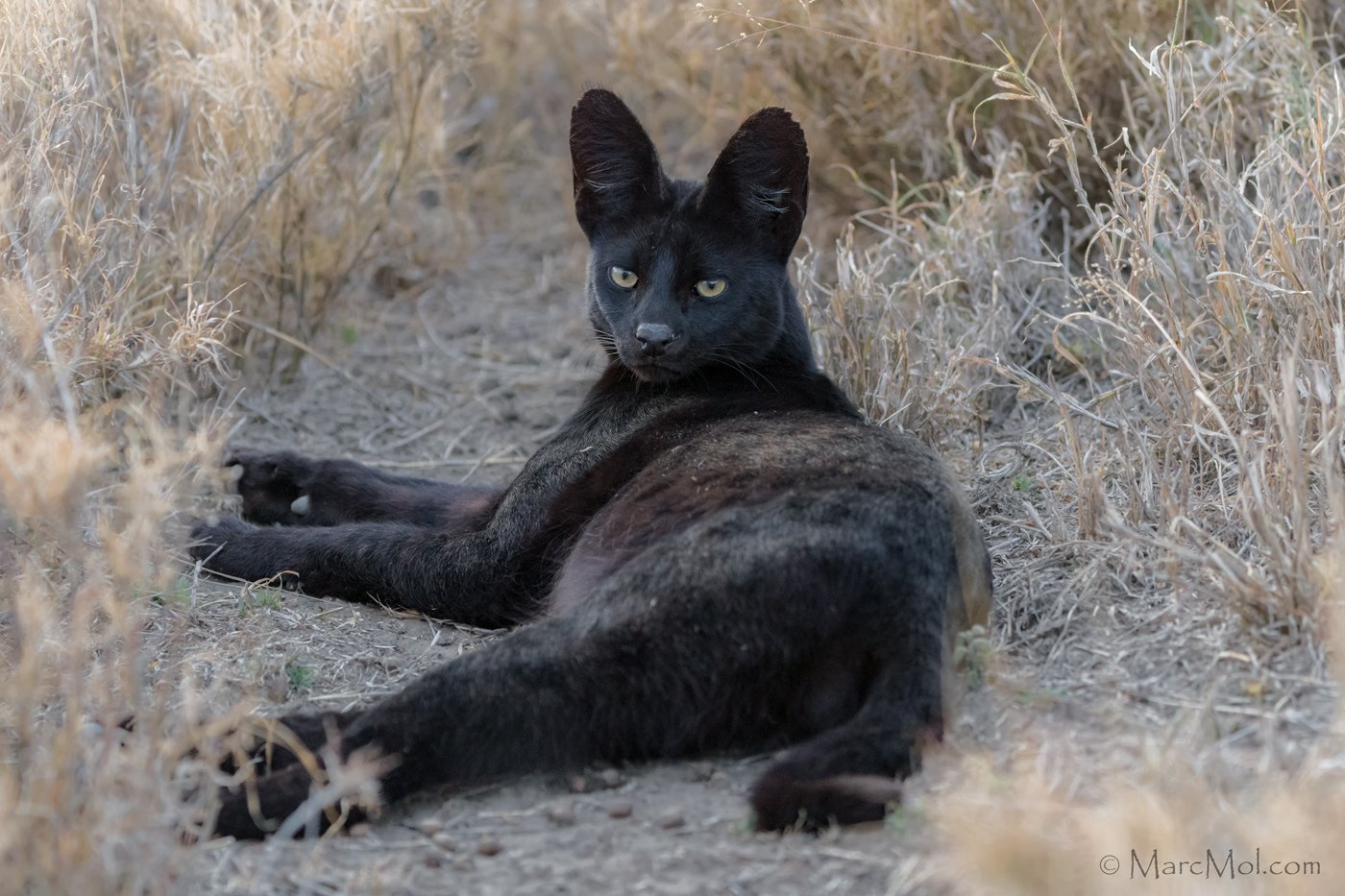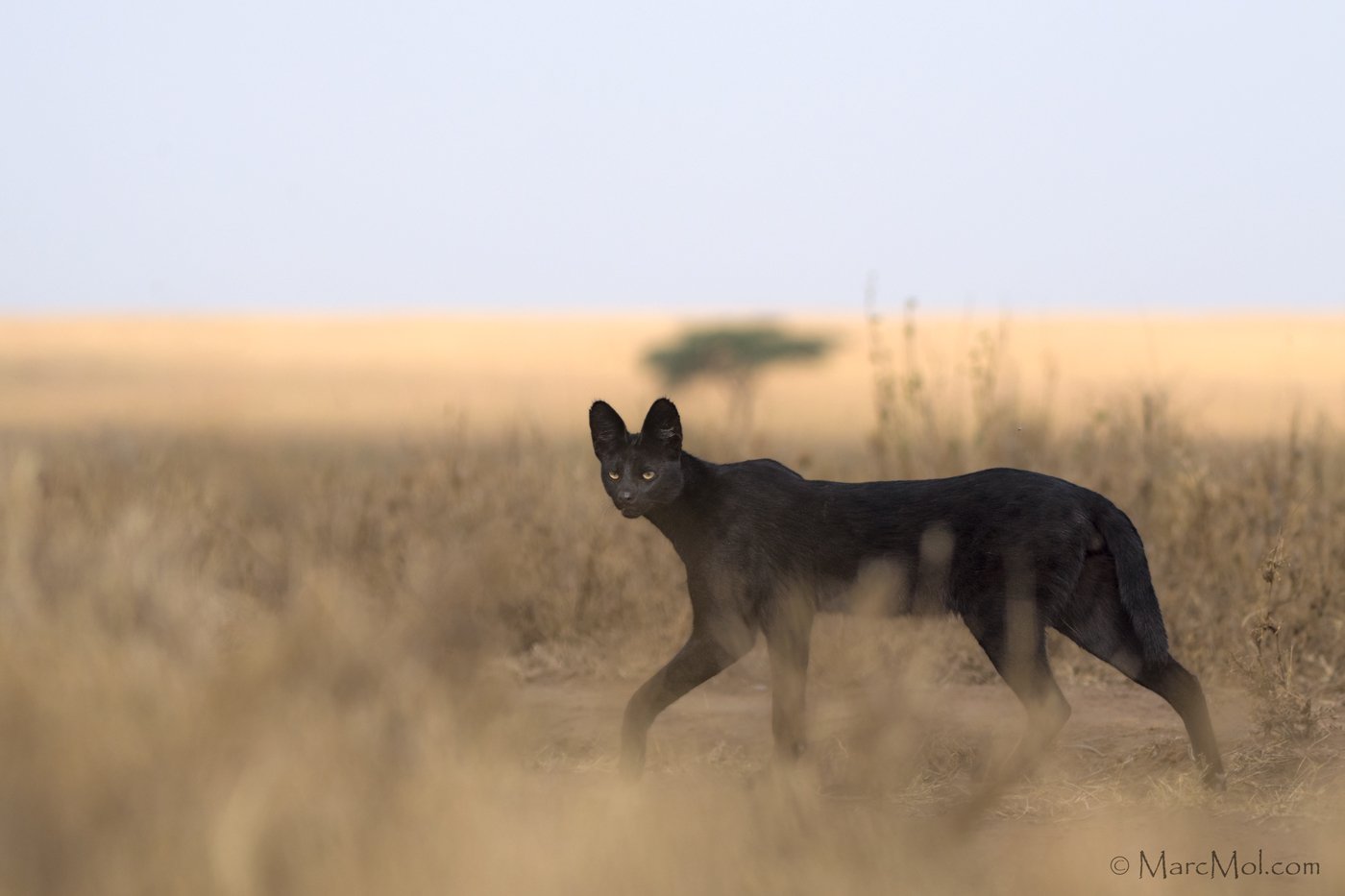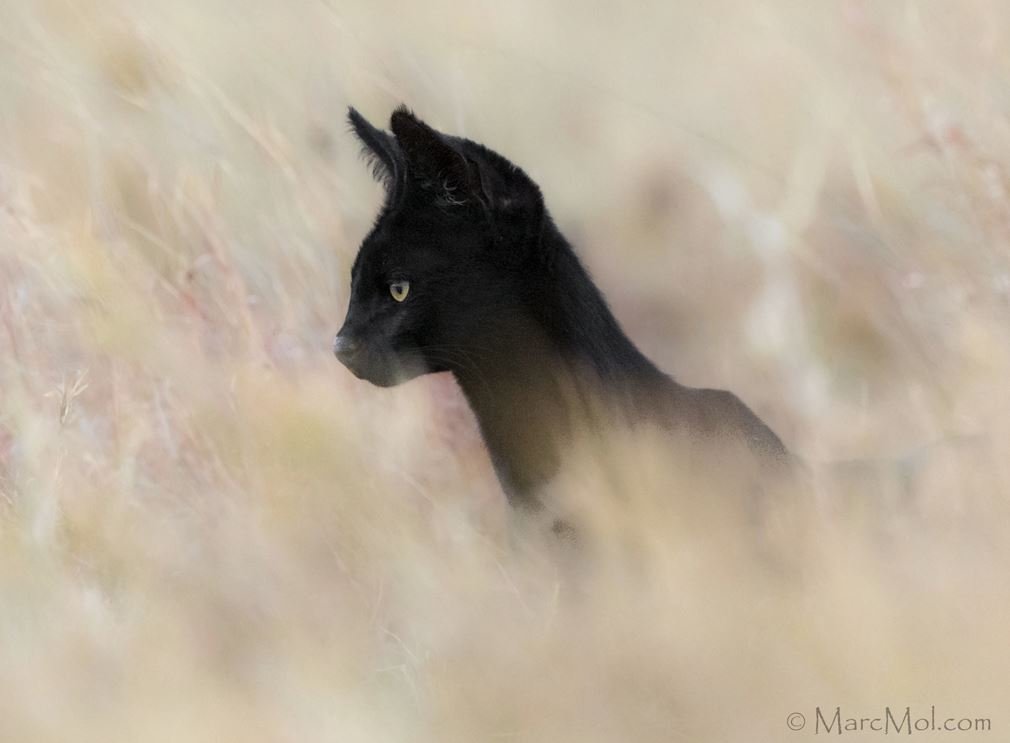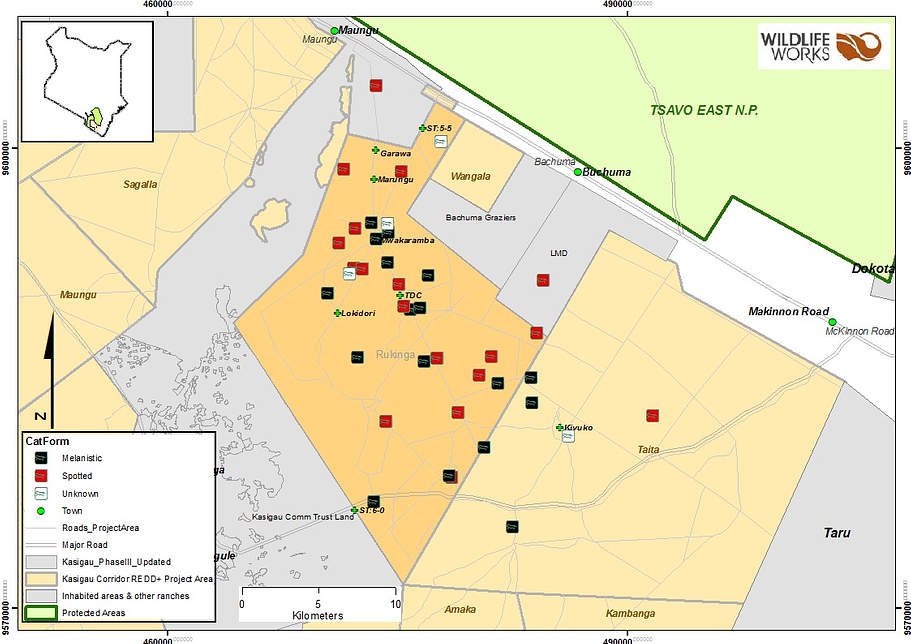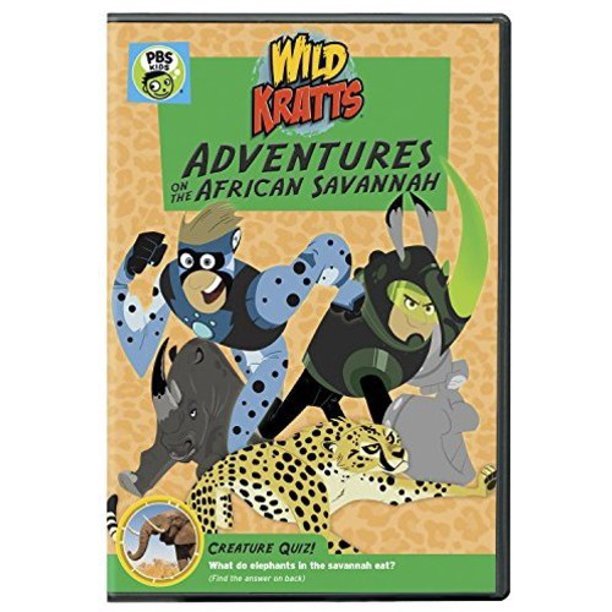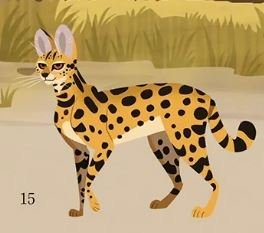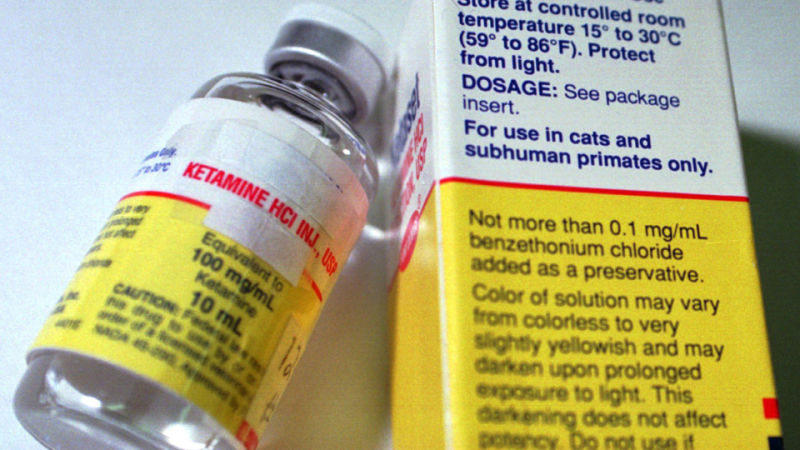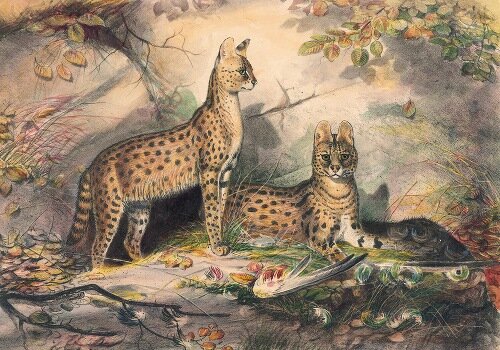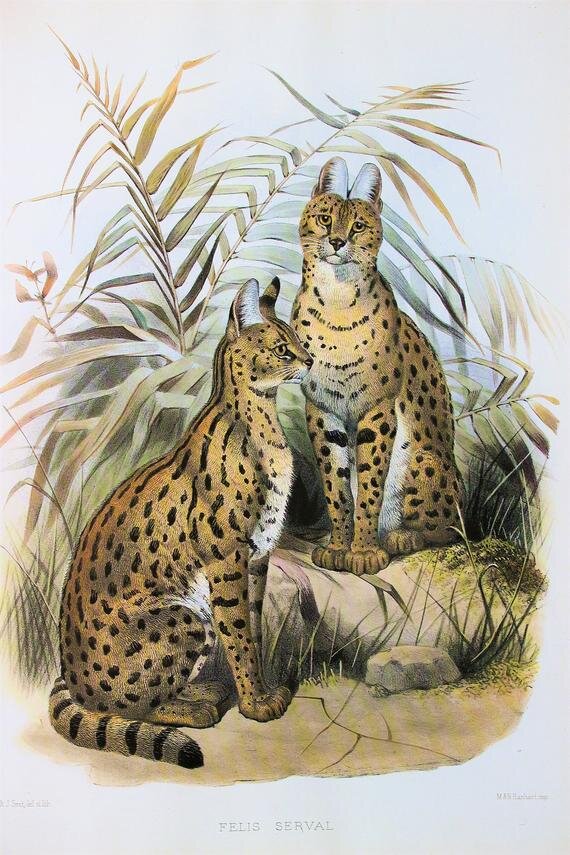Savannah Cat Personality
The personality of the Savannah Kitten is outgoing, in-your-face, extremely curious, and high energy. They want to be involved in everything. They will pout when they don't get what they wanted. And fully capable of knocking every kick knack over. "Savandalism" is the price you pay for a bored energetic cat that is not properly mentally stimulated. A bored Savannah Cat is like having an unhappy toddler.
Owners of Savannah Cats love the intelligence this wonderful breed has and moreover the challenge of providing proper mental stimulation. For most owners providing enrichment is an extremely rewarding experience that results in desired overall behavior. If you travel a lot and can not bring your devoted Savannah Cat then this breed is not for you. They will become depressed with out there beloved owner! They bond strongly and are very very VERY loyal.
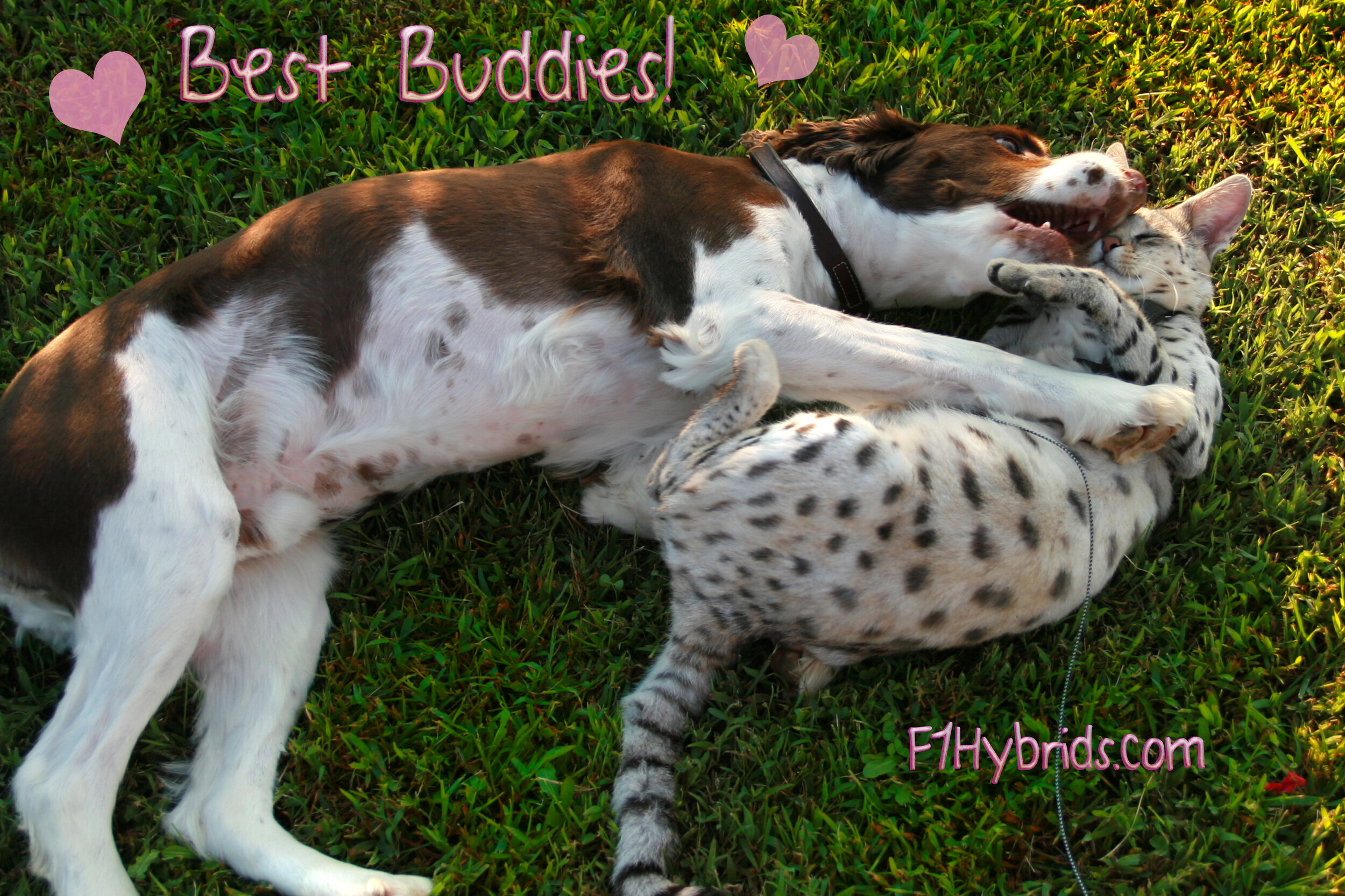
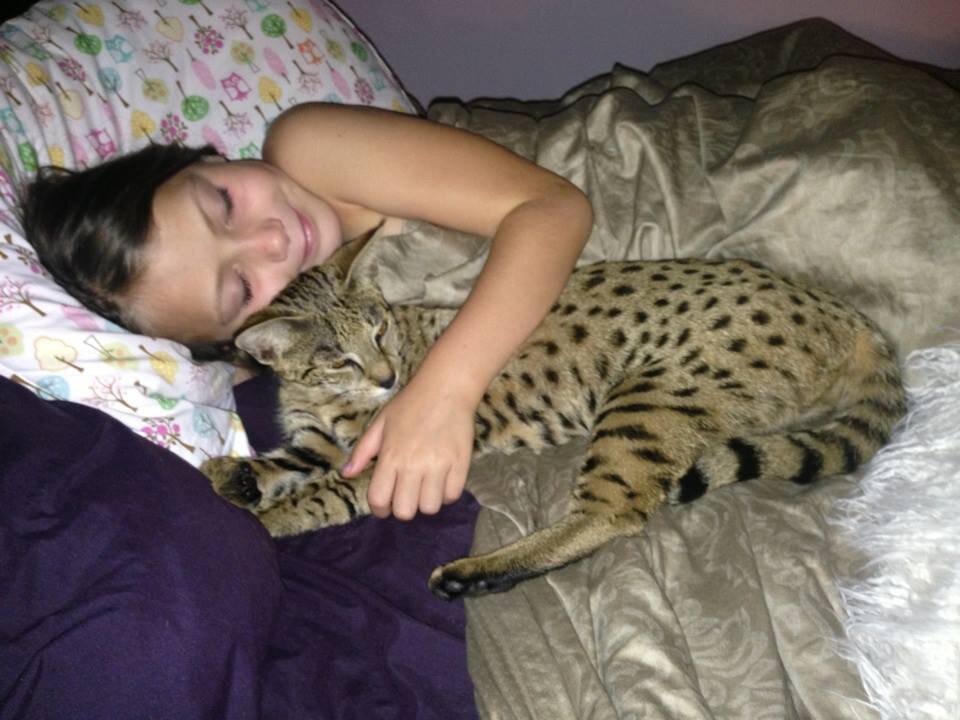
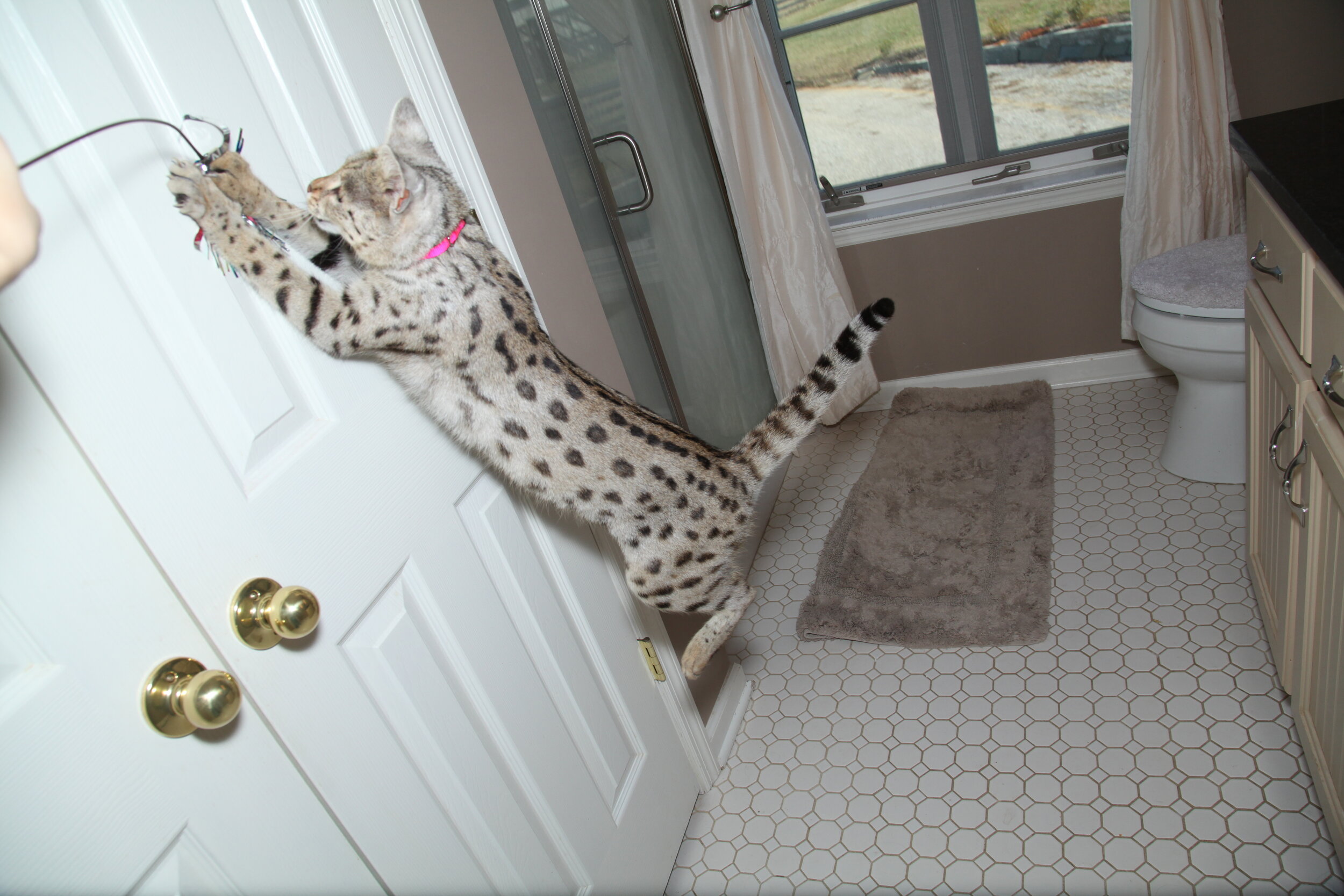
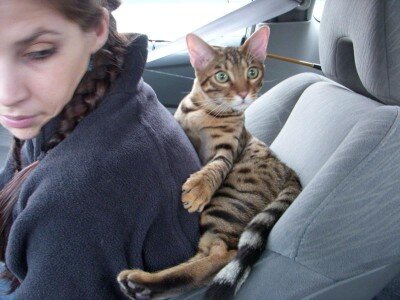
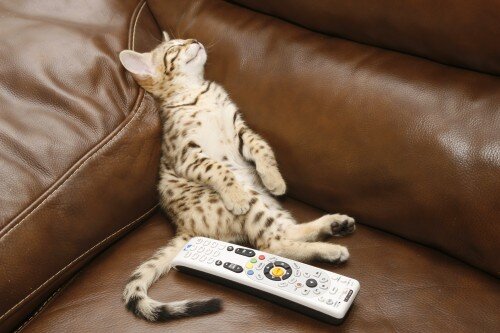
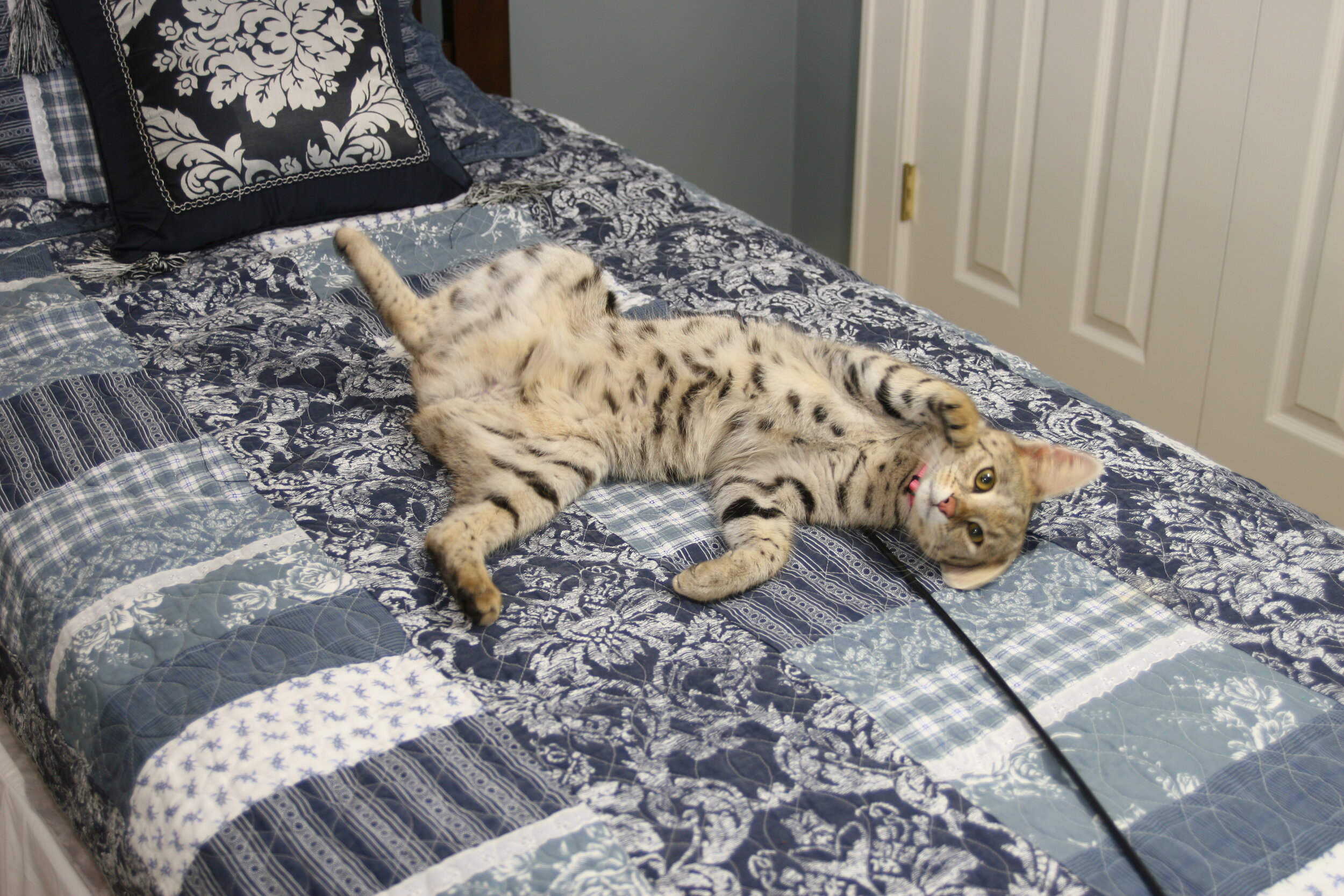
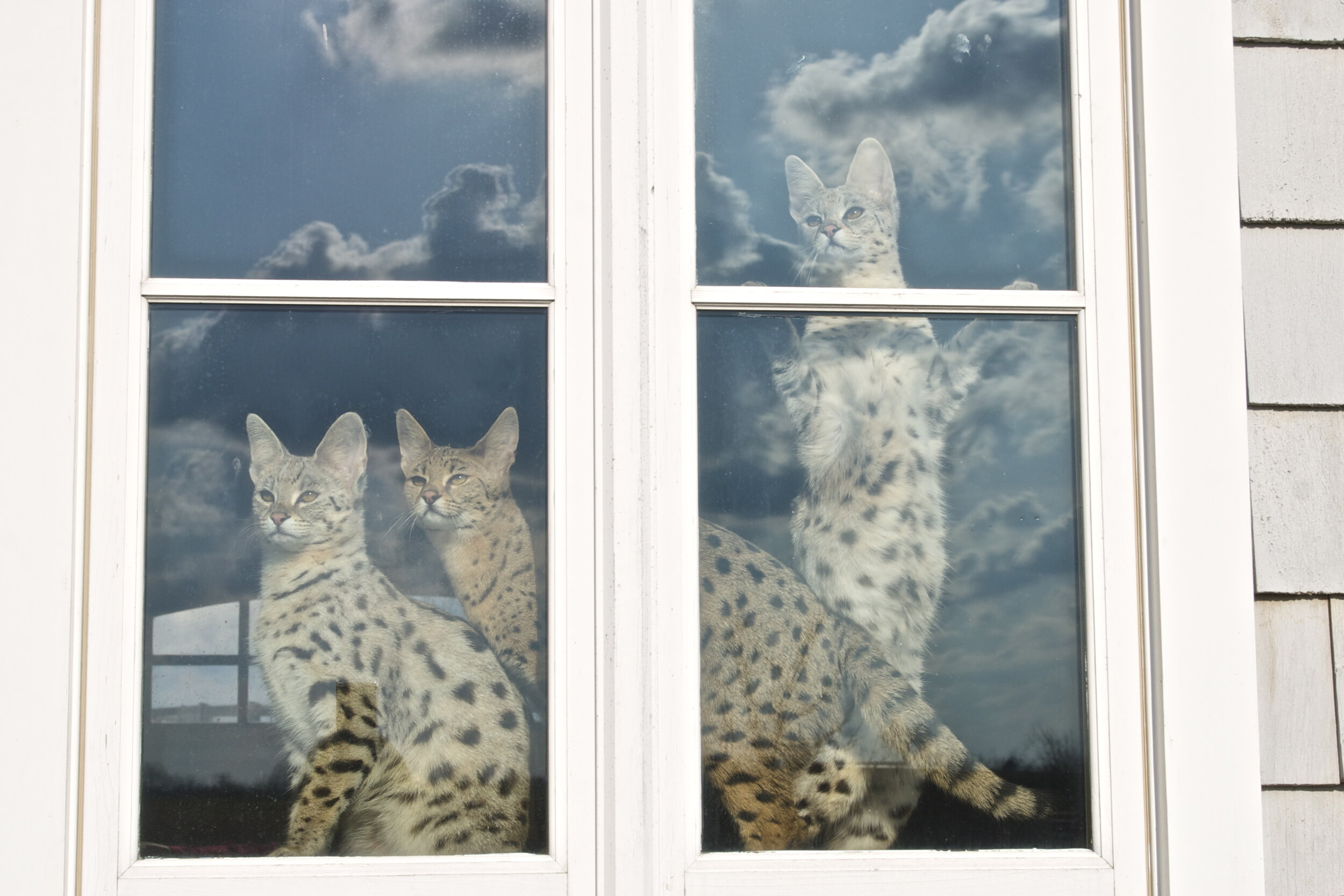
Savannah cats are not dangerous to people!
People are the real danger when it comes to animals. Any breed of cat that is mistreated or not properly raised (socialized, training, mental stimulation, exercise) can be dangerous… ANY BREED OF CAT. Blaming the breed is a dismissal of ones own fault. To be fair many cat owners truly do not understand how to handle ANY BREED of cat. This is proven by watching “my cat from hell” which clearly shows the patterns of misunderstanding of cat owners.
F1 Savannah cats are not dangerous to humans, humans are the danger! Serval Cats are not inherently dangerous to people, Serval Cats will run away from strangers and will almost always choose “flight” over “fight”! Certainly like any cat you must respect and treat it properly.
All cat breeds have hunting instincts, which means the individual may pose a danger to smaller pets such as prey animals (rodents, birds, and fish).
IMPORTANT!!! Any animal (cat, dog, bird, horse, etc) can be a nightmare if you intend to not respect what the individual animal needs for a well-balanced life. PLEASE evaluate what animal you can properly provide the optimal home!
Fetch
Savannah Cats love playing fetch and often don’t need any reinforcement to start playing fetch. Playing fetch may be considered a dog’s domain, but a cat’s natural hunting instincts of stalking and pouncing make it the perfect game for felines, as well. Cats are not generally known for following commands, but it’s not a huge stretch to imagine why cats would enjoy chasing a moving object when you consider how the game mimics a hunt.
Walking On A Leash
Purring
For a long time, we all believed that a purring cat is a happy cat. Cats purr in a variety of situations including, bizarrely, those in which they feel threatened or nervous. Experts theorize that at least some of the time purring may be a gesture of appeasement or submission.
On the other hand, this explanation provides no clues as to why cats often purr when they are injured, ill or giving birth. In these cases, it may be that the vibration itself, rather than the noise or a human’s response to it, is soothing to the cat.
It is worth mentioning, however, that cats seem to have figured out that they can get their owners’ attention by purring; cats that want something add a high-pitched sound to their purrs that is particularly difficult to ignore.
Water
While it is true that many domestic cats dislike being wet, it is by no means a universal rule; in fact, some breeds such as Savannah Cats, Maine Coons, and Turkish Van cats in particular are fascinated by water and may happily go for a swim if given the chance.
Even the average domestic cat may enjoy playing in shallow water or running water.
Large cats like leopards and lions that live in hot climates tend to enjoy splashing around in the water, but domestic cats often live in more temperate regions of the world and may avoid getting wet in order to preserve body heat.
Kneading
You probably know how irritating this particular feline habit can be; your cat is about to curl up on your lap when suddenly she decides to spend several minutes pawing before settling down. This behavior is likely an instinct left over either from the distant past or from kittenhood.
Given that cats often fall asleep after kneading, some animal behaviorists speculate that the behavior may reflect the now obsolete need to make a nest; your cat’s wild ancestors may have kneaded in order to flatten brush and soften the ground. Alternatively, kneading may mimic the actions of a kitten pawing its mother’s teat to stimulate milk production.
Generally speaking, Savannah Cats only knead when they are feeling particularly content, so when your cat has her claws sunk deep into your thigh, at least you can take some dubious comfort in the knowledge that she appreciates you.
Rub Against Objects
Given how much most cats enjoy being petted, you might very well assume that a cat rubbing against a doorway or his owner’s leg is seeking a similar sensation—sort of like scratching an itch that you can’t reach yourself by rubbing against something else.
The truth, however, seems to be a bit more complicated. Cats are naturally territorial, and they possess scent glands throughout their bodies that they use to indicate what “belongs” to them.
A cat that rubs against your legs is likely marking you as “his”; any cat that comes along later will smell your kitty’s scent on you and know to back off.
Licking
We all know how fastidious cats are about keeping their coats clean. Don’t be insulted, though, if your cat tries to “wash” you.
It’s unlikely that your cat thinks you’re dirty or at least, dirtier than any other human.
Like many animals, cats use grooming as a form of bonding; if you own multiple cats that have grown up together, you have likely noticed them washing each other at some point.
If your cat tries to lick you, you can be sure she sees you as a friend.
Pictures Showing Personality
View more Savannah Cat Pictures!
Savannah Cat Patterns
The only accepted pattern on a Savannah Cat is spots.
Savannah Cats Pattern is spotted only which is the only accepted by TICA. Solid one-color spots are the only pattern found on the African Serval Cat, due to this fact Spots are the pattern acceptable. The spots should follow across the body and not be connected.
Pictures are of correct horizontal spotting pattern!
Non-standard patterns are recessive domestic patterns. Nothing is wrong with breeding a non-standard patterns if said cat posses above average breed type. If the cat is only average breed confirmation with non-standard quality then it should not be in a breeding program. The following statement is an example of "selling" non-standard patterns. Rosettes are non-standard because Serval Cats do not have rosettes. If you desire rosettes they are a approved Bengal pattern.
F2 Savannah Kitten Showing Horizontal Pattern
Ocelli Ear Mark
Ocelli Ear Mark is a round light-colored spot on the back of the ears. Although very common in wild cat this marking can be found throught nature, most commonly on the wings of butterflies. Serval Cats have an "ocelli" marking behind the ears which are high-contrast marks that are thought to scare off predators by mimicking the eyes of the predators' own enemies. Savannah Cats inherit this marking from the Serval Cat however it is often a muted version with less contrast. Typically lacking the high contrast of black with white color combination. It is considered desirable to have black with white but not a fault to have lesser contrasting colors (black with brown, brown with brown).
Non-Standard Coat Traits
White toes
White lockets of hair
Blue eyes
Marble pattern
Servaline pattern
Ticked pattern
Long hair
Curly hair
Hairless
Expression Of White
Expression of solid white and larger patches of white should not be present on a Savannah Cat and will result in a penalty within the show ring but not a disqualification. It is thought that white servals may be the result of white being expressed on the coat as illustrated in the below diagram. Although this is possibly true it is also a known fact that such serval cats have never existed in the wild and have happened a few select times due to inbreeding in captivity. All the Serval Cats pictured below were produced by inbred bloodlines. The all-white serval on the far right developed a tumor on his nose (thought to be due to the pink pigment on the nose) and it had to be removed.
Servaline Pattern
Here we have two wild Serval Cats from the same region with different patterns. Servaline (ticked pattern) on the left, you can see what looks like the beginnings of two-toned rosettes (no definite outline). Certainly, this would be considered a one-off pattern without more evidence. The ticked Servaline pattern with only one color has been documented in the wild. On right, we see the traditional spotted pattern. The Serval on the right is likely male considering his thick cheeks and overall thicker body.
Notice the flow of solid spots on this F1 Savannah Cat
Savannah Cat Colors
Savannah Cats come in TICA accepted colors include black, brown, smoke and brown spotted tabby.
Savannah Cat Colors are meant to resemble its ancestor the Serval Cat, accepted colors are brown, silver, black, and smoke. The Serval Cat has a bright buttery golden base coat with solid black spots. This golden color is a shade of brown spotted tabby and must be registered as a brown spotted tabby or BST.
Brown Spotted Tabby = Aguoti Cat (A-)
Silver Spotted Tabby = Aguoti Cat (A-) + Inhibitor gene
Black = Non-Aguoti Cat (AA)
Smoke = Non-Aguoti Cat (AA) + Inhibitor gene
Brown Spotted Tabby (BST)
Aguoti Cat (A-)
Silver Spotted Tabby
Aguoti Cat (A-) + Inhibitor gene
Non-standard Savannah Cat Colors
Non-standard Savannah Cat Colors are color(s) that disqualify a cat from being shown and additionally have an "undesirable" trait within the said breed. These exist within all pedigree breeds. These cats can still be as valuable as a standard cat within a breeding program depending on what type of desired traits it possesses verse non-desirable traits. Should a Savannah Cat possess exceptional breed body confirmation but has a recessive non-standard pattern the cat can not be shown but can be within a breeding program. However, non-standards should not be offered to or purchased by any new breeder, only a very experienced breeder should attempt using non-standards as they are likely to offer advanced breeding challenges. Any breeder would prefer to keep the standard spotted coat but good judgment must be made on if the non-standard cat may be worthy of breeding.
Cinnamon - Recessive
Chocolate - Recessive
Fawn - Dilute of cinnamon
Blue - Dilute of black
Lilac - Dilute of chocolate
All colors must go through the breed committee to be accepted by TICA to be shown as an "accepted color". Colors currently accepted are meant to resemble the ancestor of the African Serval Cat. However, by default, some coloration must be, view the following example to learn how this is applied. Each time a color is accepted breeders evaluate how genetically it will impact the breed. For instance when silver coloration was accepted that meant breeders were accepting the "inhibitor gene" which suppresses the brown color.
inhibitor gene
The inhibitor gene eliminates yellow pigment in the agouti hairs of the background color but does not affect the non-agouti areas (the markings). The inhibitor gene may suppress all or very little of the yellow pigment which results in some cats appearing a washed-out brown color. This gene does not effect the health of a Savannah Cat in any way. This yellow pigment that shows through is referred to as "Tarnish" or "Tarnishing". Below the kitten on the left is a brown spotted tabby, the kitten on the left is a heavily tarnished silver spotted tabby. In-person, the kitten on right appears almost a creamy milk or tan.
Picture: Inhibitor Gene Impact Diagram
Example: Smoke color (Black cat + Inhibitor Gene) was accepted due to accepting silver (Brown + Inhibitor Gene).
Savannah Cat History
Savannah Cat History starting in the 1990's. Who is patrick kelly and joyce soufe?
Savannah Cat Breed Timeline
April 7, 1986 - Judee Frank crossbred a male serval, belonging to Suzi Wood, with a Siamese domestic cat to produce the first Savannah cat, a female named Savannah. That first Savannah was bred with a Turkish Angora male and gave birth to viable F2 kittens in April 1989. Documented by Suzi Wood in the Long Island Ocelot Club (LIOC) Newsletter, Vol 30 Number 6, Page 15, Nov/Dec 1986. This reported the birth of an 8 oz female hybrid on April 7th 1986. The kitten, named Savannah, was born to a Seal Point Siamese cat and sired by a 30-35 lb serval called "Ernie" in Pennsylvania. Her weight from birth through to placement was comparable to that of an average serval cub of the same timespan. Her rapid growth and weight gain then tapered off, but she remained consistently larger than a domestic kitten of the same age and was 10 lbs at 6 months old.
April 5, 1989 - Suzi and Mike Mutascio bred the first F1 Savannah (Named Savannah) with a solid white 13 lb. champion male Turkish Angora called Albert II, owned by Lori Buchko of Hightstown, New Jersey. Savannah (First F1 Savannah) had 3 F2 Savannah kittens on April 5, 1989. Two survived. The first kitten was male (solid white) and a female (torbie). Suzi Mutascio sold the F1 Savannah (named Savannah) to Lori Buchko. Lori Buchko then sold an F2 Savannah female (intact) named Kitty and Kitty’s red spotted F3 son to Patrick Kelly.
1990’s - Joyce Sroufe (A1 Savannahs) starts actively breeding Savannah Cats. She was formerly New Horizon Bengals before switching to A1Savannahs.
1996 - Patrick Kelly, Karen Sausman, and Joyce Sroufe wrote the first Savannah Standard.
1997 - Joyce Sroufe introduced the breed at a major cat show in Westchester, New York. This was the judges their first look at a Savannah Cat.
1998 - Joyce Sroufe and her Savannahs were featured headliners of the Westchester, New York show and made television appearances and interviews including: 20/20, CNN, People Magazine, and others.
Lorre Smith became the first TICA Savannah Breed Chair. Lorre Smith started her cattery (Afrikan Savannahs) in 1995.
2000 - Patrick Kelly with the help of Leslie Bowers (executive secretary of TICA) completed the first application to get the Savannah breed accepted by TICA into the New Breed program.
2001 (February) - Savannah Cats gained registration-only status. Meaning cats can be registered but not shown.
2001 (October) - Savannah Cats gain exhibition-only status. Meaning F3 (third generation), or further removed, could go into a show hall and exhibit.
2002 - The first TICA show to include the Savannah Breed was held in Oklahoma City that May.
2006 - Carol Streit of C&C Savannahs became breed chair.
2006 - The Canadian Cat Association issued the Savannah cat formal Registration AND Exhibition status.
2011 - TICA Savannah Breed Section voted to advance the breed from “Advanced New Breed” to “Championship Status” to be effective May of 2012.
2012 - Brigitte Cowell Ph.D. (Kirembo Savannahs) was elected TICA Savannah Breed Chair
2012 - TICA accepts the breed for champion statues in the show ring.
2012 - A1Savannahs “Lightening” of AList Savannahs became TICA’s first Supreme Grand Champion Savannah Cat.
Suzi and Mike Mutascio
Suzi and Mike Mutascio, in 1989, bred the first F1 Savannah (Named Savannah) with a solid white Turkish Angora (Named Albert II). Savannah had 3 F2 Savannah kittens on April 5, 1989. Two survived. The first kitten was male (solid white) and a female (torbie). Suzi Mutascio sold the F1 Savannah (named Savannah) to Lori Buchko. Lori Buchko then sold an F2 Savannah female (intact) named Kitty and Kitty’s red spotted F3 son to Patrick Kelly.
Below are photos are from "FCF - The Feline Conservation Federation" Volume 41, Issue 5—September/October 2007. Initially published in the LIOC-ESCF July/August 1989 Newsletter, written by Suzi Wood Mustacio.
Patrick Kelly
Patrick Kelly
Patrick Kelly was and continues to this day to be instrumental in the development and promotion of the Savannah Cat Breed although he is not a breeder.
In late 1989 Patrick saw the Savannah Cat featured in the Long Island Ocelot Club (L.I.O.C.) newsletter. Patrick then met Bill Scroufe at the Lolly Brothers Auction. Bill Scroufe was there to sell some serval kittens for his wife Joyce Scroufe. At this time Joyce did not breed Savannah Cats. He began talking with Joyce by phone and went to visit her home where she bred Bengals, Servals, Caracals, Cougars, and Canadian Lynx.
Patrick started the process of recognition by The International Cat Association as a Championship breed in 1996. He went forward completing the application to have the Savannah Breed accepted into the New Breed Program and he wrote the first Savannah Standard with the help of Joyce Sroufe. Unfortunately, when Patrick presented the Breed Standard he found out that new breeds were not being accepted for 2 more years which then got pushed out 2 more years. That meant it would not be till the year 2000 to even be considered!
In 2021 Patrick started producing F1 Savannah Kittens at his cattery located in the Philippines! The very first F1 Savannahs in the Philippines. Congratulations on your diligent efforts paying off!
Joyce Sroufe, A1 Savannahs
A1Savannahs was the world's first Savannah Cattery. A1Savannahs was started under the name “New Horizon Bengals” then changed names. Joyce orginaly bred Bengals along with various other exotic cats. With the urging of Patrick Kelly she tried to produce F1 Savannahs.
In 1994, Joyce Sroufe produced her first litter of F1 Savannah Kittens.
A1Savannahs was the world's first Savannah Cattery to breed down to later generations and produce fertile Savannah males.
Kathrin & Martin Stucki, A1 Savannahs
Ponca City, Oklahoma, USA - Raymond, New Hampshire, USA
Kathrin Stucki was Swiss and married Martin Stucki. Being Bilingual they were instrumental in selling breeding cats in other countries helped by the fact they could speak German, Spanish and French. A1Savannahs (Stucki Family) was the world’s first Savannah Cattery to breed SBT Savannah cats. A1Savannahs (Stucki Family) was the world's first Savannah Cattery to breed the largest domesticated house cat documented in the Guinness Book of World Records.
In December 2007 Teardropssavannahs in England had the right of sole importership of A1 Savannahs cats into the UK.
The Guinness Book of World Records (TM) confirmed: Scarlett’s Magic bred and raised by A1Savannahs was the record holder for the largest pet cat in the world in 2010/2011. A1Savannahs (Stucki Family) had Savannah Kittens appeared on CBS and CNN News. Others model for Macy’s Catalog or help people with disabilities in a hands-on program. We have been featured in several magazine articles in the United States as well as around the world and have been filmed by international tv stations.
Accomplishments Of A1Savannahs (Stucki Owned)
2011 - A1savannahs featured in Lemmikki Magazine
2011 - A1savannahs featured in Pulo do Gato Edition 44
A1Savannahs featured in the Cat Fancy Magazine in 2014
Kathrin Stucki of A1 Savannahs Introduction to the Savannah Cat
Martin Stucki
Engster Family, A1 Savannahs
Martin Engster
In September 2013, The Engster Family partnered with Dana Fulton toke over the role of improving and advancing the Savannah Breed. Martin Engster was formerly a Sergeant with The United States Marine Corps from Oct 1998 - Sep 2006 (8 years) (Fox Btry 2/14). In 2021 A1Savannahs announced it would permanently be closing its cattery due to Covid-19.
A1Savannahs was the world’s first Savannah Cattery to produce a Supreme Grand Champion. In TICA, the highest title awarded to cats in championship classes. Supreme Grand Champion A1Savannahs Lightning is owned and shown by Janet Spain. In 2016 A1Savannahs Caline was also names Supreme Grand Champion in only a few shows, this is a great accomplishment!
Accomplishments Of A1Savannahs (Engster Owned)
2012 - World's first Savannah Cat to win Supreme Grand Champion Title
SGC A1Savannahs Lightning
Owned and loved by Janet Spain
In TICA, this is the highest title awarded to cats in the championship classes. A cat must first become a Quadruple Grand Champion before it can begin to compete towards the title of Supreme Grand Champion.
2013 - Silver Spotted Tabby of the Year
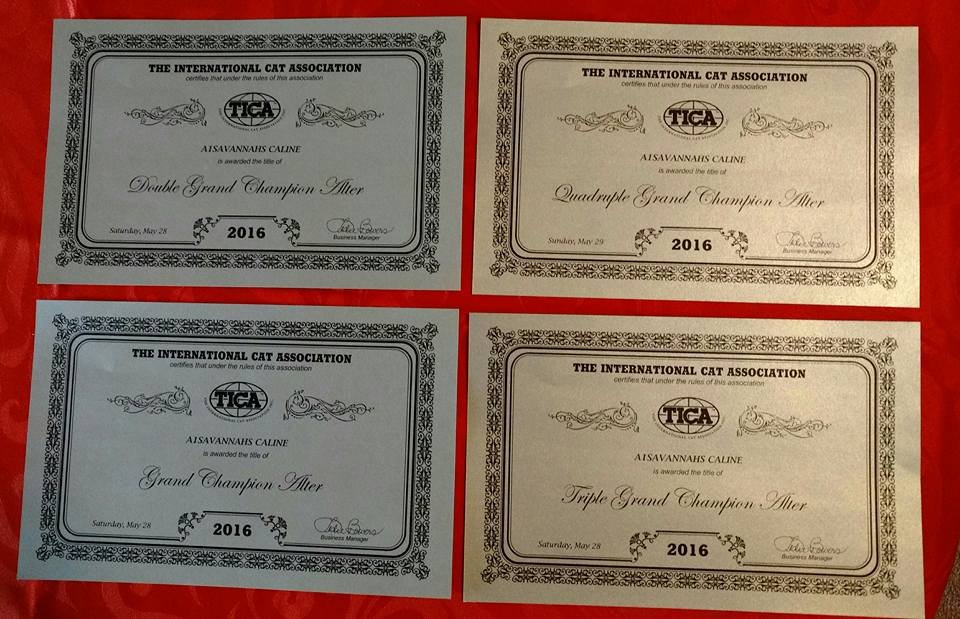
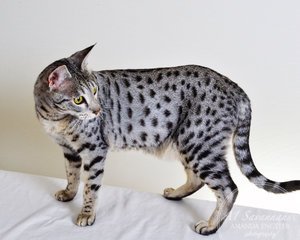
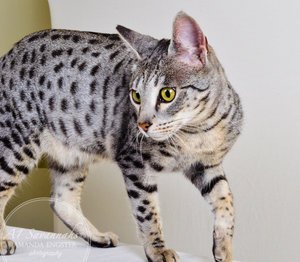
2016 - Caline Quadruple Grand Champion
Lisa Jeffery, Spots On The Lake
Lisa Jeffery singlehandedly brought the Savannah breed to acceptance in the Canadian Cat Association (CCA) in 2006.
Fun Fact
The Bengal Cat had already been around for over 15 years at the time the Savannah Cat had first been produced. Diffculties producing the Bengal Cat along with tempermant inherited by the Asian Leopard into the first generations of Bengals is though to have put breeders off from wanting to try other hybrid crosses.
Savannah Cat Size
Savannah Cats appear larger in size because generally, they are large. Savannahs are tall, long, and of substance (not dainty). Most size statistics are over-exaggerated. The largest documented weight was an F1 Savannah Cat at 30 pounds.
F1, F2 Savannahs: Weight 17-25 pounds. Height of 14"-17"
SBT Savannahs: Weight 12-16 pounds. Height of 10"-13"
The Guinness Book of World Records(TM) confirmed that Scarlett's Magic who was bred and raised by A1 Savannahs was the record holder for the largest pet cat in the world in 2010/2011.
2016 - Arcturus Aldebaran Powers, a Savannah cat from Southfield, Michigan, is now the World's Tallest Domestic Cat according to Guinness World Records. Unfortunately, he has gone to rainbow bridge due to a house fire (He still hold the record). Verified on 3 Nov 2016
Arcturus Powers (F2 Savannah Cat) was 19 inches tall.
Lauren and Will Powers are very proud to own not one but TWO record-breaking felines at their home in Ferndale, Michigan – one is the tallest cat ever and the other has the longest tail on a cat ever. Read more: http://bit.ly/GWR-Cats
World Record Longest Tail On A Cat ever measures 44.66 cm (17.58 inches) and belongs to Cygnus Powers.
World Record Tallest Domestic Cat is Arcturus Alderbaran Powers who measures 48.4 cm (19.05 in) and weighs about 30 pounds.
Savannah Cat Non-Standards
Non-standard are cats with traits that are none desired with in the breed.
Non-standards are trait(s) that disqualify a cat from being shown and additionally have an "undesirable" trait within the said breed. These exist within all pedigree breeds. These cats can still be as valuable as a standard cat within a breeding program depending on what type of desired traits it posses verse non-desirable traits.
Should a Savannah Cat possess exceptional breed body confirmation but has a recessive non-standard pattern the cat can not be shown but can be within a breeding program. However non-standards should never be offered to or purchased by any new breeder, only a very experienced breeder should attempt using non-standards as they are likely to offer advanced breeding challenges.
Any breeder would prefer to keep the standard spotted coat but good judgment must be made on if the non-standard cat may be worthy of breeding.
Non-standard Colors
Cinnamon - Recessive
Chocolate - Recessive
Fawn - Dilute of cinnamon
Blue - Dilute of black
Lilac - Dilute of chocolate
Non-standard Traits
White patches of hair including toes
Blue or odd-colored eyes
Rosetted, Marble or Servaline (ticked) pattern
Long, curly, or no hair.
Examples
British Shorthair kittens showing full colors and their respective dilutions. Red (left); Red diluted to cream (second from left); Black (second from right); Black diluted to gray (right)
NOTE: Black (Refered to as melanistic) is a standard (correct) color in Savannah Cats.
British Shorthair kittens showing full colors and their respective dilutions. Red (left); Red diluted to cream (second from left); Black (second from right); Black diluted to gray (right)
© Nynke Van Holten | Paid for usage
Dilution Of Color
Dilution causes uneven distribution of the pigment in the fur shaft, dilution of all colors. Pigment granules in the hair shaft are clumped and unevenly distributed, producing dilution of coat colors. For example, black pigment is diluted to gray and red is diluted to cream.
Explanation of Results:
Cats with D/D genotype will be full-colored and cannot transmit this dilute variant to their offspring.
Cats with D/d genotype will be full-colored and are carriers of this dilute variant. Matings between two carriers of dilute are predicted to produce 25% dilute kittens.
Cats with d/d genotype will display dilute coat color(s) and will transmit this dilute variant to all of their offspring. Matings with other d/d genotype cats are expected to produce all dilute offspring.
Chart showing the effects of dilute on cats with eumelanin pigmentation and cats with phaeomelanin pigmentation. ©UC Davis Laboratories
Expression Of White
White lockets and larger patches should not be present on a Savannah Cat and will result in penalty within the show ring but not disqualification. It is thought that white servals maybe the result of white being expressed on the coat as illustrated in the below diagram. Although this is possibly true it is also a known fact that such serval cats have never existed in the wild and have happened a few select times due to inbreeding in captivity.
All the Serval Cats pictured below were produced by inbred bloodlines. The all white serval on the far right developed a tumor on his nose (thought to be due to the pink pigment on the nose) and it had to be removed.
Serval Cats
Serval Cats are medium-sized African wild cats. The Serval Cat is mated with a domestic cat to produce a hybrid cat breed called the Savannah Cat. They have long and slender bodies, with distinctive ears and legs (Markula et al., 2009). They have the longest legs and biggest ears in relation to body size for any cat species (Livingston, 2009). The backs of their ears are black with noticeable central white bars (Ocile). They also have small heads, elongated necks, long slender bodies, and short tails.
© F1Hybrids Savannah Cats | Serval Cat Information
Their coat color is a yellowish tan (almost a butter yellow) with black spots, bands, and stripes, which are unique to each individual. Serval Cats can jump straight up 7ft into the air in a single bound. They have short tails that have black spots and rings (Markula et al., 2009). Servals with black coats have been reported, as well as rare sightings of white Servals (IUCN, 1996). Males are bigger than females (San Diego Zoo, 2010).
The serval is a carnivore that preys on rodents, particularly vlei rats, small birds, frogs, insects, and reptiles, and also feeds on grass that can facilitate digestion or act as an emetic. Up to 90% of the preyed animals weigh less than 200 grams (7 oz).
With its large ears the Serval uses echolocation to detect prey hidden in the grasses. Then using their long legs and incredible jumping power Servals can leap vertically up to three meters to catch birds flushed from the grasses.
Genetically the serval (Leptailurus serval) is closely related to the African golden cat (Caracal aurata) and the caracal (Caracal caracal). No recent morphological and molecular studies have been conducted
Leptailurus serval serval in southern Africa
Leptailurus serval constantina in West and Central Africa and
Leptailurus serval lipostictus in East Africa
Distribution of Leptailurus serval (Breitenmoser-Wursten et al., 2008). © REDLIST
Habitat
Serval Cats are found in sub-Saharan Africa, distributed from Senegal and Guinea in the west to Ethiopia and southern Somalia in the east and south to Angola, Zimbabwe, and Mozambique (Breitbeil, 2002) (See Figure 1).
There is the possibility have been reported that Servals are also found north of the Sahara in Morocco and possibly northern Algeria. (Breitenmoser-Wursten et al., 2008).[TJ1]
Servals were also once found in Tunisia but went extinct however a population has been reintroduced into Feijda National Park (Breitenmoser-Wurstenetal.,2008).
Tropical grasslands include the hot savannahs of sub-Saharan Africa and northern Australia. Rainfall can vary across grasslands from season to season and year to year, ranging from 10 to 40 inches annually.
Temperatures can go below freezing in temperate grasslands to above 90 degrees Fahrenheit.
Diet
Servals are strict carnivores (Mellen & Wildt, 1998), however, there have been various accounts of them consuming vegetation in the wild (Breitbeil, 2002). They are specialized rodent hunters, rats being the dominant rodent they catch followed by mice (IUCN, 1996).
They are also excellent jumpers, extending their prey capture to birds and insects (Livingston, 2009). In addition to rodents, birds and insects they will also eat reptiles and amphibians (IUCN, 1996). A scat analysis of a wild population showed they have a diet consisting of 60% rat, 15% mice, 5.6% birds and small amount of insects and reptiles (Markula et al., 2009). They are capable of hunting and capturing larger prey such as small antelope, rabbits (Markula et al., 2009) and flamingos (Livingston, 2009).
The Serval is an opportunistic predator and being that most of their prey is small in size they hunt frequently. It has been estimated that an adult Serval will spend 6 hours hunting and travelling in a 24 hour period, making several kills in that time (Markula et al., 2009). They have a high prey catch success rate of 48%, one of the highest of Felidae species (Livingston, 2009).
Their long legs and big ears provide various hunting techniques. Servals can be patient hunters using their excellent hearing to pinpoint the exact location of their prey, whether it’s moving through long grass or underground. Their long legs not only provide an advantage on land but also in water and getting up into the air. They are known to hunt in shallow waters for frogs, fish and water birds (Sunquist & Sunquist, 2002). On land they can dig, use their long arms down animal burrows, zigzag bound through grass and pounce on prey.
They use the force of their forearms to strike their prey when pouncing on it. Their legs also propel them into the air, being able to leap horizontally 1-4m and vertically 3.5m, allowing them to catch insects and birds mid-flight (Markula et al., 2009). They have been seen clawing at the prey in flight or slapping them between their front paws (Livingston, 2009).
Behavior
Servals are solitary animals, only coming together when the female is in oestrus (Breitbeil, 2002). Male and female have their own territories, with the male territory being bigger and overlapping into several female territories (Markula et al., 2009,, San Diego Zoo, 2010).
Territories are marked with urine sprays and faeces, (San Diego Zoo, 2010), with males marking at least twice as much as females (Sunquist & Sunquist, 2002). It has been estimated that the density of Servals in an area is one to every 2.4 kilometres. Females show strong site fidelity, occupying the same territory for many years (Sunquist & Sunquist, 2002).
Servals are mostly crepuscular and nocturnal but are also known to be active during the day (Breitbeil, 2002), which one may attribute to human presence and larger predators’ times of activity (San Diego Zoo, 2010). Servals tend to be inactive for at least 40% of the day, usually during the hottest part of the day (San Diego Zoo, 2010). When active they can cover as much as 3-6 kilometres in one night (Sunquist & Sunquist, 2002).
Reproduction
Male and female Servals will come together during a female oestrus, which happens several times a year and each oestrus can last 1-4 days. The pair will sometimes travel and rest together during the female’s oestrus (Sunquist & Sunquist, 2002). Females can give birth twice a year, with a minimum interval of 184 days. Gestation in the wild is estimated at 66-77 days, with an average litter size of 2-3 kittens (Markula et al., 2009). The month they give birth is usually before peak rodent reproduction (Wilson & Mittermeier, 2009) but fall in different months in the various locations in Africa (Sunquist & Sunquist, 2002). Birthing dens are hidden in dense vegetation or disused Aardvark or Porcupine burrows (Wilson & Mittermeier, 2009).
Pattern
There are two different spot patterns for servals. In the more generally known pattern, the tawny-colored fur is covered with large black spots. The lesser-known serval fur pattern is called “Servaline” where a lighter-colored fur is covered with faint, speckled spotting. Instead of the absence of dark tabby markings, the markings have increased in number and decreased in size to the extent that they are hardly noticable.
Spotted Pattern (Pictured on left)
Servaline Pattern (Pictured on right)
Melanism
Melanism, a development of the dark-colored pigment melanin in the skin or its appendages, has been described in many species globally. In cats (Felidae) it is well-documented in leopards (Panthera pardus), and to a lesser degree Jaguars, Ocelots and other smaller cats. The reasons for the prominence of melanism in cats are not well understood. However, several theories posit that melanism is particularly relevant in high-altitude areas and forests, where cats are likely to be less exposed to open sunlight.
Manja — the melanistic serval first spotted at Namiri Plains in 2019 by Asilia guide and naturalist of the same name — and his mate have produced melanistic serval kittens.
wildlife photographer Will Burrard-Lucas
Serval sightings recorded in the Tsavo ecosystem.
Map 1 (above) - Serval sightings recorded in the Tsavo ecosystem.
Map 2 (below) - Serval sightings recorded in Rukinga - Taita area (within Tsavo ecosystem). Wildlife Works compiled the data on serval sightings in the Tsavo Ecosystem.
Serval sightings recorded in Rukinga - Taita area (within Tsavo ecosystem). Wildlife Works compiled the data on serval sightings in the Tsavo Ecosystem.
Population Status
[TJ1]According to IUCN there have been reports from Morocco (and under wild populations you’ve said there are fewer than 250 mature animals there) Might also be good to mention they have bee reintroduced to Tunisia and that they are believed to be extinct in Algeria.
The IUCN red list lists Servals as “Least Concern” as they are relatively abundant and widespread in their range and have a stable population trend (Breitenmoser-Wursten et al., 2008). It is estimated that there are at least 50,000 individuals in the wild (WAZA, 2012). However the isolated population north of the Sahara in Morocco is classified Critically Endangered for that region. It is estimated that there are fewer than 250 mature individuals in that population (Breitenmoser-Wursten et al., 2008).
High carnivore population density highlights the conservation value of industrialized sites. Camera trap image of a serval at the heavily industrialized Secunda Synfuels Operations plant in South Africa, recorded by Reconyx Hyperfire HC600 camera.
The Serval is protected under CITES (Convention on International Trade in Endangered Species) Appendix II, however national legislation does not provide protection over most of its range. The Serval is under Appendix II on CITES because this species “is not necessarily now threatened with extinction but that may become so unless trade is closely controlled.” An export permit or re-export permit is required for international trade of this species (UNEP-WCMC, 2012).
Hunting is prohibited in Algeria, Botswana, Congo, Kenya, Liberia, Mozambique, Nigeria, Rwanda, South Africa (Cape Province only). Hunting is regulated in Angola, Burkina Faso, Cental African Republic, Ghana, Malawi, Senegal, Sierra Leone, Somalia, Tanzania, Togo, Zaire and Zambia. There is no legal protection in Benin, Cameroon, Ethiopia, Gabon, Gambia, Guinea Bissau, Ivory Coast, Lesotho, Malawi, Mauritania, Morocco, Namibia, Niger, South Africa, Sudan, Swaziland, Tunisia, Uganda and Zimbabwe (IUCN, 1996).
A key threat to the Serval is the degradation and loss of the wetland habitat. Their main food source, rodents, is in high densities in wetland habitats in comparison to other habitats. Also burning of grassland habitats can reduce Serval prey as well (IUCN, 1996). Other threats include capture for their pelts and use of body parts in traditional medicines (Breitenmoser-Wursten et al., 2008).
Captivity
Servals are raised in captivity. Out of all exotic felines kept in captivity, they are notably more driven for human interaction but not without several drawbacks. Serval cats will not entirely use a litter-box. They also are singular animals with deep bonds with only one given caretaker, they strongly dislike strangers and will be driven to flee away. Servals hit emotional maturity at ~3 years old, this is when their youthful personality will reveal the true exotic nature of the adult feline become distinctly independent.
Kid Education
PBS Kids, Wild Kratts Video
REFERENCES
Husbandry for Leptailurus serval (September 2012)
Arliah Hayward (Mammals Keeper, Carnivores)
Adelaide Zoo, Adelaide, Australia
zoossa.com.au
Andrews, P. (2003) Hand-rearing of small felids. Hexagon Farm Wild Feline Breeding Facility.
Breitbeil, B. (2002) Serval, Leptailurus serval. North American Regional Studbook 1st Ed. FL, USA.
Breitenmoser-Wursten, C., Henschel, P. & Sogbohossou, E. 2008. Leptailurus serval. In: IUCN 2011. IUCN Red List of Threatened Species. Version 2011.1. <www.iucnredlist.org>. Downloaded on 02 October 2011
Crissey, S.D., Slifka, K.A., Shumway, P. & Spencer, S.B. (2001) Handling Frozen/Thawed Meat and Prey Items Fed to Captive Exotic Animals. A Manual of Standard Operating Procedures. United States Department of Agriculture (USDA).
Daily Mail (2008) “Shakira the Serval kitten finds puppy love in her adoptive home…with a pack of Rhodesian Ridgebacks” <www.dailymail.co.uk> > Dowloaded on 19 September 2012
Department of Agriculture, Fisheries & Forestry (DAFF) (2009) Draft Australian Animal Welfare Standards & Guidelines: exhibited animals. DAFF Animal Welfare Branch <www.daff.goc.au/_data/assets/pdf_file/0006/762846/draft-animal-exhibit-standards.pdf
Goodrowe, K.L. (1992) Feline reproduction and artificial breeding technologies. Animal Reproduction Science 28: 389-397
Hedburg, G.E. (2002) Exotic Felids. IN: Gage, L. (ed.) Hand-rearing wild and domestic mammals. Ames, Iowa State Press, USA. Pgs. 207-220.
Hosey, G., Melfi, V. & Pankhurst, S. (2009) Zoo animals: behaviour, management and welfare. OUP Oxford, UK
Howe, A. (2011) Carnivore vaccinations at Monarto Zoo. University of Sydney. Unpublished research paper.
IATA (2007) Live Animals Regulations. International Animal Transport Association. Montreal, Quebec
IATA (2013) Live Animals Regulations. International Animal Transport Association. Montreal, Quebec
International Species Information System, ISIS (2014) Weight comparison report- Serval. <https://zims.isis.org> downloaded on 26 February 2014
IUCN (1996) Sub-Saharan Africa Species Accounts: Serval, Leptailurus serval. IUCN/SSC Cat Specialist Group <http://www.catsg.org/catsgportal/cat-website/catfolk/serval01.htm> downloaded on 01 May 2012
Kasa (2002) Reproduction bio-technologies in the conservation of wild animal species< www.kasa.org.br/projectoeliasing.doc> downloaded on 03 September 2012
Livingston, S.E. (2009) The nutrition and natural history of the Serval (Felis serval) and Caracal (Caracal caracal). Vet Clin Exot Anim 12: 327-334
Lopate, C. (2012) Management of pregnant and neonatal dogs, cats and exotic pets. Wiley & Blackwell, USA
Markula, A., Hannan-Jones, M. & Csurhes, S. (2009) Pest animal risk assessment: Serval, Leptailurus serval. Invasive Plants and Animals, Biosecurity Queensland, Department of Primary Industries and Fisheries, Brisbane, QLD.
McLelland, D. (2012) Preventative Medicine Program, Serval. Adelaide Zoo
Mellen, J.D. (1991) Factors influencing reproductive success in small captive exotic felids (Felis spp): a multiple regression analysis. Zoo Biology 10: 95-110
Mellen, J.D. (1992) Effects of early rearing experience on subsequent adult sexual behaviour using domestic cats (Felis catus) as a model for exotic small felids. Zoo Biology 11: 17-3
Mellen, J.D. (1993) A comparative analysis of scent-marking, social and reproductive behaviour in 20 species of small cats (Felis sp). American Zoologist, 33: No. 2, 151-166
Mellen, J.D. (1997) Minimum Husbandry Guidelines for Mammals: Small Felids. American Association of Zoos and Aquariums (AZA)
Mellen, J.D. & Wildt, D. (1998) AZA small felid husbandry manual. American Association of Zoos and Aquariums (AZA)
NSW Department of Primary Industries (NSW DPI) (2005) Standards for Exhibiting Carnivores in New South Wales. Exhibited Animals Protection Act 1986, NSW Department of Primary Industries. NSW, AU.
Robbins, A. (2011) Annual report for Serval. Species coordinator. Auckland Zoo
San Diego Zoo (2010) Serval Fact Sheet. San Diego Zoo Global Library <http://library.sandiegozoo.org/factsheets/serval/serval.html> downloaded on May 01, 2012
Schmalz-Peixoto, K.E. (2003) Factors affecting breeding in captive Carnivora. University of Oxford, Oxford. Unpublished thesis
Shepherdson, D.J., Carlstead, K., Mellen, J.D. & Seidensticker, J. (1993) The influence of food presentation on the behaviour of small cats in confined environments. Zoo Biology 12: 203-216
Skipper, G. (2011) Zoos SA Animal Management Policies and Procedures: Animal Transfers. Zoos SA, Australia
Sunquist, M. & Sunquist, F. (2002) Wild Cats of the World. University of Chicago Press, IL, USA. pp.143-151
UNEP-WCMC (2012). Serval. UNEP-WCMC Species Database: CITES-Listed Species <http://www.cites.org/eng/resources/species.html>
downloaded on 03 September 2012
Wackernagel, H. (1968) A note on breeding the serval cat, Felis serval, at Basle Zoo. International Zoo Yearbook, Vol. 8, no. 1, pp. 46-47
WAZA (2012) Serval. World Association of Zoos and Aquariums. <http://www.waza.org/en/zoo/visit_the_zoo/cats-1254385523/leptailurus-serval> downloaded on September 03, 2012
Weigl, R. (2005) Longevity of mammals in captivity; from the living collections of the world. Kleine Senckenberg-Reihe. Stuttgart, Germany
Wilson, D.E. & Mittermeier, R.A. eds. (2009) Handbook of The Mammasl of the World Vol. 1. Carnivores. Lynx Edicions, Barcelona.
Savannah Cat Health
Health information pertaining to Savannah Cats.
No known well-established health problems exist within the Savannah Cat breed, they are susceptible to the same health issues as any other cat. Breeding cats should be tested to prevent common feline health issues.
Breeders should DNA test for minimum PKD and PRA.
All breeds of cat can get both Congenital Issues and Non-congenital Issues. The main health issue faced by a Savannah Cat owners is obstruction due to ingestion of a small toy such as feather, piece of rubber or piece of plastic.
Savannah Cat owners sometimes buy inappropriate cat toys that are easily destroyed and swallowed because they are cute, inexpensive and the cats enjoy them. Unfortunately, such cat toys can be too small, lightweight, and easily swallowed. Small domestic cats should not even have these seriously hazardous toys. Consult with your breeder if you have issues finding safe cat toys.
Congenital Health Issues
Congenital health issues are genetically inherited by linage. Many cats with congenital defects can still maintain a high quality of life. Treatment options for abnormalities vary as for any health issue. Defects can occur anytime in the developmental stages of the embryo or fetus. The cause of many congenital defects is unknown. Environmental circumstances during pregnancy may lead to a predisposition to certain defects.
Cleft palates
Polydactylism (extra toes)
Dwarfism
Extra vertebrae
Hydrocephalus
Liver Shunt
Non-congenital Health Issue
Non-congenital health issues are caused by none genetic related issues. Non-congenital health issues include fungal, bacterial and viral infections.
Bacterial infections
Urinary tract infection
Giardia
Cocidia
Campylobacteriosis
G-strep
Viral infections
Upper respiratory infection (URI)
Fungal Infections
Ringworm
Should you think your Savannah Cat might be sick you should immediately inform the breeder and your veterinarian. If you feel the veterinarian is not taking your concerns seriously it is never a bad idea to get a second option from another veterinarian.
Diarrhea
Diarrhea Loose, and frequent stools are the most common symptoms of diarrhea. Other signs include flatulence, the passage of blood in mucus or stool, and straining to defecate. Lethargy, dehydration, fever, vomiting, decreased appetite, weight loss, and an increased urgency to defecate may also accompany diarrhea. Diarrhea should never be ignored. It may shock you to know millions of people in the USA have parasitic infections whose symptoms often go unnoticed or are misdiagnosed. These microscopic creatures are typically picked up through food and water. The same can be said for our pets. Your veterinarian will want to rule out other possibilities for the intestinal infection, such as improper digestion (maldigestion), unabsorbed nutrients (malabsorption), or inflammatory bowel disease (IBD) prior to recommending a treatment option for your cat.
What Causes Diarrhea?
Change in diet
Dairy or other food intolerance
Ingestion of spoiled food
Allergic reaction
Bacterial or viral infection
Internal parasites, such as roundworms, coccidia and Giardia
Inflammatory bowel disease
Kidney or liver disease
Cancer or other tumors of the digestive tract
Certain medications
Hyperthyroidism
Colitis
Parasites
Tritrichomonas
Tritrichomonas foetus (T. foetus) is a single-celled protozoan that lives in the colon of cats and is shed in the feces. Adult cats may or may not show signs, but can still be carriers of the parasite, passing it into the environment through their feces, and putting uninfected cats at risk of acquiring it. Symptoms may not appear in an infected animal for years after being exposed. The main symptom is a longstanding bout of loose smelly stools, sometimes mixed with blood or mucus. Cats may have difficulty passing the loose stools and strain to empty the bowels. Stool may leak out of the anus and cause redness and pain around the area.
Giardia
A cat becomes infected with Giardia after swallowing the cyst stage of the parasite. Once inside the cat's intestine, the cyst goes through transformation to the trophozoite or feeding form of the organism and attaches to the intestinal wall to feed. Eventually the cat passes infectious cysts in its stool. These cysts are immediately able to infect another animal. Giardiasis can be transmitted by eating or sniffing the cysts from contaminated ground, or by drinking contaminated water. Very resistant to freezing and municipal water chlorination. Younger animals are most likely to have diarrhea as the result of infection. Adult cats may or may not show signs, but can still be carriers of the parasite, passing it into the environment through their feces, and putting uninfected cats at risk of acquiring it. Symptoms may not appear in an infected animal for years after being exposed.
Roundworms
Roundworms are the most common intestinal parasite of cats, affecting 25% to 75% of cats, with higher rates in kittens. Adult roundworms are three to five inches long, cream-colored, and live in the cat’s intestine, where they don’t attach to the intestinal walls and survive by eating food ingested by the host. Adult female worms produce fertile eggs that are passed in the infected cat’s feces. The eggs require several days to several weeks to develop into the infective larval stage. Cats become infected with Toxocara cati by ingesting eggs or rodents (transport hosts) that have larvae in their tissues.
Hookworms
Hookworms are slender, thread-like worms, less than a half-inch long, that live attached to the lining of the wall of the intestine, where they feed on the blood of the host. Because of their small size, they usually are not visible in the feces of infected cats. Hookworms are long-lived, capable of living as long as a cat. Less common than roundworm infections, the prevalence of feline hookworm infections varies considerably by geographic location in North America.
Coccidia
Coccidia is a microscopic one-celled organism. Virtually all cats become infected with Isospora felis during their life, usually by eating a cyst, a thick-walled, egg-like stage that is passed in the feces and matures in the soil. Cysts can be infective within six hours of being excreted in feces. Cats may also become infected by eating flies or cockroaches that carry Isospora cysts.
Protocols
Should your cat present with diarrhea:
DO NOT IGNORE. PREVENT DHYDRATION.
Keep the cat completely separate from other animals
Disinfect all litter boxes with bleach water.
Go to the vet for a fecal check.
Should your cat be diagnosed with an internal parasite:
Research all treatment options.
Consult with your veterinarian on the best treatment.
Keep the cat completely separate from other animals.
Try to contain the cat in an easy to disinfect the area.
Disinfect the litter box daily.
Switch temporarily to a cheap non-clumping litter so you can throw away the litter daily.
Disinfect yourself when handling said animal or litter-box.
Note this is for optimal results to limit the stress to owner and spread of parasite.
Anesthesia Risk Of Ketamine
Ketamine doesn't have a good reversal agent. Serval Cats have two features that puts them at risk. A cat with a higher stress level results in more catecholamines ahead of surgery, meaning to get them asleep it takes a higher dose of anesthesia than what may be safe for such a lean body mass. When the catecholamines dissipate before the ketamine wear off it can then be too strong.
Side Effects Of Ketamine
Impaired judgment
Flashbacks
Confusion
Overdose
Respiratory Depression
Tachycardia or a “dramatic increase in heart rate”
Aggressive Behavior
References
Tritrichomonas
https://veterinaryresearch.biomedcentral.com/articles/10.1186/s13567-015-0169-0
Gastrointestinal Parasites of Cats
https://www2.vet.cornell.edu/departments-centers-and-institutes/cornell-feline-health-center/health-information/feline-health-topics/gastrointestinal-parasites-cats
Ziggy Do Cat Wheels
ZiggyDoo is the distributor of FerrisCatWheel for North America providing safe indoor exercise and loads of fun for your cat! The Ferris Cat Wheel is designed for cats, providing safe indoor exercise, mental stimulation and loads of fun (especially important for indoor cats). Affordable pricing, flexible payment options and free delivery.
DELUXE wheelbase for maximum support !
Active high energy cat breeds such as bengals and many other breeds are known to take to the Ferris Cat Wheel with enthusiasm (see photos below).
Protection for little paws and tails
Base skate wheels are safely positioned tucked into the wheelbase out of harm's reach of little paws and tails
Protect your cat's spine
A 48-inch inner wheel diameter allows your cat to move freely without excessive arching of the back, which will protect your cat's spine (smaller wheels will cause spinal strain or stress)
Safely walk, run, gallop and play
the 5mm EVA foam tiles line the 12-inch width running track so your cat can move with confidence and comfort. sturdy wheelbase constructed for stability, better wheel movement, and performance
Savannah Cat Scammers
Scammers will shut down one website then open another!
Identify and stop scammers.
List Of Scammers
Loft Savannah Cats
Frontline Savannah Catas
Excellent Savannahs
Golden Savannahs
Mothers Care Savannah Cattery
Cheerful Savannah Cats
Baseline Savannah Cats
Example Scam: https://exoticcattery.com/
Ranks high in google search! Read the website, its ripped off content from various breeders. The pictures are also stolen with a watermark added. Notice how much effort went into this website!
Look at the photos from A1Savannahs (Now retired, no longer breeder, legit breeder). These are the stolen photos shown above!
⚠ WARNING: Stolen photos!
⚠ WARNING: Stolen photos!
If you see these photos a website they are stolen.
Verified Scam Websites




How to avoid scammers?
TICA Registration
Scammers are quickly identifiable as not TICA registered. Verify your breeder is TICA registered by asking for their membership card, their voluntary code of ethics, and TICA.org website listing. All these items are easy to verify by calling TICA. www.TICA.org
Ask For A Video
Photos are easier to steal than videos. You can otherwise ask for a photo with your name in the picture.
Pick Up Your Kitten In Person
We additionally suggest picking your kitten up in person. When you pick up in person you're ensuring your kitten and breeder are real prior to leaving.
Notice Scammers
Just to show how elaborate a website can be see the scammers below. Many websites are copy and pasted to different domain names. Scammers simply change domain names once they are identified. Breeders can not get all these domains taken down, you as a buyer need to prove these are legit breeders. These pictures are all STOLEN, this is why it is important to watermark photos. Please take note of these pictures as they are often used.
State Ownership Laws
State Laws for ownership of hybrid cats and hybrid dogs changes so rapidly that we suggest visiting www.HybridLaw.com for current information. Hybrids found in banned areas have been and can be collected legally euthanized.
Each link below leads to www.HybridLaw.com
We apologize HybridLaw.com is Down. Technical problems. unusable at this time.
Please use HYBRIDSLAW.org
Northeast States
Connecticut
Maine
Massachusetts
New Hampshire
Rhode Island
Vermont
Mid-Atlantic States
DC
Delaware
Maryland
New Jersey
New York
Pennsylvania
Virginia
West Virginia
Southeast States
Alabama
Arkansas
Florida
Georgia
Kentucky
Louisiana
Mississippi
North Carolina
South Carolina
Tennessee
Midwest States
Illinois
Indiana
Iowa
Kansas
Michigan
Minnesota
Missouri
Nebraska
North Dakota
Ohio
South Dakota
Wisconsin
Southwest States
Arizona
California
Colorado
Nevada
New Mexico
Oklahoma
Texas
Utah
Northwest States
Idaho
Montana
Oregon
Washington
Wyoming
Other States and Territories
Alaska
Hawaii
International Laws
Australia
Austria
Belgium
Brazil
Canada
Czech Republic
Denmark
Finland
France
Northern Ireland
Hungary
Italy
Japan
Lithuania
Netherlands
Norway
New Zealand
Poland
Portugal
Singapore
Sweden
Switzerland
UK
Are Savannah cats illegal? Most states allow private ownership of Savannah Cats, individual counties can pass further restrictions. Lawmakers are starting to understand that Savannah Cats have included in-laws meant for pure exotic cats. If a state restricts F1, F2, and F3 it will usually allow F4 (fourth-generation) or further removed from the African Serval Cat. All generations of Savannah cats are illegal in Georgia, Hawaii, Nebraska, and Rhode Island.
Are Savannah cats illegal in California? It is legal to own a Savannah cat in California, even without a permit. This includes Savannah cats of all Filial (F) generations and is true of any hybrid cat that has not been bred or mixed with a big, or serval (wild) cat.
Savannah Cat Shipping
Pick-up your kitten at the airport or breeder’s home!
We highly recommend picking up your kitten in person. It is optimal for you to see the kitten prior to it leaving the breeder and for you to meet your breeder. We understand visiting from out of state may be inconvenient but it is worth the trip.
As of 2017, it is against the law for a breeder to ship "sight unseen" via cargo if they are not a USDA licensed commercial facility. This is for the buyer's protection. By picking it up in person you will know the cat is real, live, and in good health.
International Shipping
We no longer offer shipping internationally. We feel it is in our cat’s best interest not to offer this option. We are friends with many long-standing breeders around the world and can refer you to a reputable breeder nearby. The proper protocol should you try to ship internationally otherwise the cat can be legally collected and then euthanized or detained indefinably.
Shipper must have an import/export license.
Buyer must have an import/export license.
The cat must be inspected by Fish & Wildlife day of departure (leaving or entering the USA).
The cat must have USDA health certificate which must be approved by USDA.
The cat must have five generations of certified TICA pedigree.
The cat must have TICA registration.
The cat must have all shots including rabies.
European countries require rabies titer.
All Savannah Cats (except F5+) require CITES paperwork leaving or entering the USA. If the are F5+ you still must meet the requirements listed above (1-8).
All of these items are required to ship into Canada as well!
Savannah Cat Price
Savannah Cat Price is based off confirmation to the breed standard. Savannah Cats are higher in price if they have traits in line with the breed standard.
The pricing of a Savannah Cat varies wildly from about $2,000 to $50,000. Every breeder has a different overhead cost and differing quality in kittens so the pricing will be subject to the individual Savannah Cat Breeder. The closer to the Serval Cat ancestor the more a kitten will cost as they are difficult to produce, larger in size, and more exotic looking.
When you consider what price you want to pay consider that breeders are obligated as TICA registered members to provide registration papers, and age-appropriate vaccinations and retain kittens until the age of 10-14 weeks, collectively this is costly.
Litter Size Effects Price
Height Effects Price
Pricing Factors
Is the breeder reputable?
The breeder microchips the kitten so if lost it is returned.
The breeder will take back a kitten if homeless.
The breeder gives age-appropriate shots.
The breeder gives parasite prevention.
The breeder spays & neuters kittens prior to placement. Preventing potential pyometra and accidental litter.
The breeder makes sure to keep a kitten till a minim of 12 weeks old. Both CFA & TICA ethics state a breeder should keep kittens for 12 weeks at the minimum. This ensures the kitten is emotionally and physically ready. Allowing a kitten to leave younger can compromise its emotional well-being and immune system for its entire life.
Can you verify the breeder?
Verify that the breeder is registered with CFA or TICA.
The breeder can verify registration by providing their cattery numbers.
The breeder can provide a verification listing through TICA.org. This listing can only be obtained by a registered TICA member with a signed code of ethics.
Unfortunately, many potential owners don’t know what to look for in a breeder and fall victims to scam websites promising cheap-priced kittens from a “reputable breeder”. NEVER EVER think you are buying a Savannah Kitten for the cheap price of $500–$1000.
Can you navigate the breeder’s website?
The breeder’s website is easy to navigate.
The breeder has a website that educates about the breed.
The breeder has a website that tells about their program.
The breeder can produce pictures of available kittens.
Are the Parents Health tested?
Minim DNA testing is for HCM, SMA, and PKD mutations.
Are the kittens Registered?
Breeder registers each litter providing buyers with registration paperwork/number.
Beware a breeder stating they don’t want to “deal with paperwork,” or they are “just producing pets.” They probably don’t have usable registration papers.
If the Seller bought a Savannah Cat with no breeding rights and then reproduced, that means they disregarded the legal contract they signed. You do not want to do business with a “breeder” who ignored a contract they agreed to uphold.
It costs a breeder $10 to register a litter of kittens with TICA. Ask yourself why would a breeder discount a kitten hundreds or even thousands for a non-registerable kitten that is purebred. Retired cats and cats with special needs could considerably cost less than the quoted average price. You would still be looking for the above-mentioned qualities in a breeder.
Savannah Cat Quarantine
“personal time with new owners”
Quarantine is a time frame of 2-3 weeks of personal one-on-one time with the new owner(s). Rushing the introduction process can result in a scared, skittish, and unsure feline that can result in unruly behavior at your fault, not the cat.
Quarantine should be in a medium-sized room. NOT A BATHROOM. This room should be ideal for the kitten to not be too confined, so the kitten does not feel threatened. You will then need to provide proper enrichment items to redirect the cat attention, provide exercise and to provide an activity to bond with your new kitten.
The most important aspect of quarantine is keeping all animals separate during introduction and eliminates typical routes of bacterial and viral infections.
Remember your kitten requires visits to the veterinarian’s office for crucial vaccinations and exams, while a kitten it's immune system is less than adult making it easy to catch something. Most animals only visit a vet when sick, take care to disinfect any surface the kitten will touch at the vet.
Sales Contracts between you and your breeder often mandate a veterinary visit within a specified brief time after arrival, this allows the vet to discover any issues that may have incurred due to stress of being re-homed or otherwise obtained. The quarantine is also the ideal time to reinforce litter box habits. In the eyes of your kitten, you must realize that your home is much larger to them than it is to you. Therefore, being in a smaller area where they can easily locate the litter box is ideal.
Be calm and quiet when you bring your kitten into your home.
Place the carrier on the floor and let the kitten come out on its own.
To encourage the kitten to come out of the carrier for the first time coax him/her out with a teaser-toy.
Keep the kitten in a small room to start, slowly allowing him/her more run of the house.
Place the kitten in the litter box several times in the first couple of days.
Sit on the floor, on the kitten’s level, to play and socialize.
First Meeting - Cat to Cat
Phase 1
Successful introductions take time. DO NOT and we repeat DO NOT try to introduce the new addition to your resident cat(s) immediately upon arrival. You may damage the new relationship irreparably and initiate fear, anger, aggression, spraying and litter box problems in the new cat and/or resident cat(s). Successful introductions take time.
Let the cats sniff out the situation. Let “smell” be the first introduction as the cats sniff each other from under the “safe room” door. Within two to four days, begin exchanging the bedding between the new and resident cat(s) daily. This helps familiarize the cats with each other’s scents.
Phase 2
Let the sniffing continue. If there are no marked signs of aggression from the cats, such as hissing and growling, the next step is to confine your resident cat to a room and let the new cat explore your house for a couple of hours each day for several days.
Phase 3
Organize a carrier meeting. Place your new cat in a carrier and put the carrier in a location of your home outside of the safe room (for example, the living room). Allow the cats to look at each other and sniff through the carrier door.
Any signs of aggression? Keep the visit short and return the new cat to its safe room.
Repeat this phase 2 to 3 times daily (if possible), until cats appear to be more comfortable with each other.
Phase 4
Let the cats meet at their own pace. If there are no signs of aggression between cats, leave the door to the safe room open a crack. This will allow the new cat to explore and/or your resident cat to visit. Supervision is necessary for the safety of both cats.
In case of aggression, have a spray bottle filled with water or a towel handy. Always stop serious threats and/or aggression immediately, as a serious fight may damage the potential for successful integration and relationship.
If over a period of weeks your integration plan is not going well, consider the installation of an inexpensive screen door from a building supply store. The screen door allows the cats to continue to get to know each other by sight and smell, while keeping both parties safe. Each cat can take turns in the screened room.
A Feliway diffuser may also prove helpful when integration is difficult.
Phase 5
You may notice some occasional hissing, swatting and grouchy behavior over the next few months (and years). This is normal. Cats are hierarchical by nature and must establish and affirm the pecking order within your household. Plus, much like humans, all cats have the occasional “off” day.
Note: Shy cats or kittens may desire companionship for your resident cat, a quicker integration may be best. Shy cats are often used to and welcome other feline companionship. They will be very lonely on their own, so we recommend that the integration take place very quickly (1-3 days) unless there are significant problems.
First Meeting - Cat to Dog
Phase 1
Follow the steps detailed in Phase 1 of the How to Introduce Cats to Cats section above.
Phase 2
If there are no other cats in your home, confine the dog to one room and let the cat begin to explore the rest of your house for one to two hours each day until the cat is familiar and comfortable with the layout of your home.
Phase 3
Bring the dog in on a leash. Once the cat is used to your home, let the cat roam loose in one room. Keep the dog on a leash and have dog treats ready in your pocket. If possible, have another person the cat is familiar with on the other side of the room to reassure and distract the cat from the dog.
Sit and meet. Keep the dog seated and focused on you as the leader. Try offering the dog a toy. If the dog focuses on or accepts the toy, reward the dog with a treat. If the dog tries to stand and move towards the cat(s), correct the dog slightly with the leash and reward him or her with a treat. If at any point the dog is not responding to your commands or the cat’s stress level appears elevated, remove the dog from the room. Keep repeating this process until the dog is responding to you and either ignoring or accepting the cat(s). This process helps teach the dog that cats are not prey, toys to be chased, or threats.
Watch. Never leave the dog and cat(s) unsupervised until you are absolutely sure they have built up a mutual, trusting and respectful relationship.
Make sure kitty has some space for alone time. Even once the cat(s) and dog(s) are comfortable with each other, cats still like having the option to retreat to a space away from the dog. Place a baby gate across the doorway of a room in the house where the cat or cats like to hang out, or buy or build a tall cat tower so they can retreat when needed.
Note: The length of time required to successfully integrate cats with dogs varies depending on the previous experiences of the animals involved. For example, your dog may have had previous encounter with a cat or the cat may have had prior experience with a dog. Often, when the cats and dogs are used to being around the other species, integration can be quicker.
Remember, integration into the rest of the house is dependent on the personality of your new cat (as well as your existing pets). Sometimes the integration process can begin in just two to four days; however, sometimes it is best to wait a couple weeks. Your cat may need a longer integration period. Consult with your breeder if you are having difficulties or even just small questions.
The sweetest kitten couldneed to most adjustment time, so do not lose hope!
Serval Cat Art, Joseph Wolf
Joseph Wolf was a German artist who specialized in natural history illustration. He moved to the British Museum in 1848 and became the preferred illustrator for explorers and naturalists including David Livingstone, Alfred Russel Wallace and Henry Walter Bates. Wolf depicted animals accurately in lifelike postures and is considered one of the great pioneers of wildlife art. Sir Edwin Landseer thought him "...without exception, the best all-round animal artist who ever lived".
Joseph was the first son of a farmer, Anton Wolf, and was born in Mörz, near Münstermaifeld, then in Rhenish Prussia, not far from the river Moselle, in the Eifel region. He was originally called Mathias but later went by the name of Joseph. In his boyhood he assiduously studied bird and animal life, and showed a remarkable capacity as a draughtsman of natural history subjects. He showed an early talent for art by cutting paper silhouettes of birds and animals which he pasted onto windows. He later took an interest in hunting. He made himself brushes from the fur of a stone marten, and drew illustrations of birds that he raised from the nest or found near his home. He took a special interest in birds of prey, and considered art as a career but realized at the age of sixteen that he needed more training to be professional. With support from his father he was apprenticed to a firm of lithographers, Gebrüder Becker at Koblenz. Here he found his first illustrated ornithology book (by Johann Conrad Susemihl—he went on to illustrate a later edition of it in the collection of a trader with an interest in birds, and was surprised by the poor quality of the plates).
Wolf travelled to Frankfurt and introduced himself as a lithographer to the ornithologist Eduard Rüppell. Rüppell was just beginning to work on the birds of Abyssinia and he encouraged Wolf to work for him either by living in Frankfurt or Darmstadt where he suggested Wolf could work for Johann Jakob Kaup. Wolf moved to Darmstadt but went on working on Rüppell's The Birds of North-East Africa. Kaup was impressed by his abilities and took one of Wolf's sketchbooks to a meeting in Leyden to show to Hermann Schlegel at the Natural History Museum, Leiden. Schlegel immediately commissioned Wolf to work on some plates for Traité de Fauconnerie. The result was a set of "magnificent paintings of birds of prey in life size" which established Wolf's reputation in Europe.
At the age of 20, Wolf was to appear at Maien to join the Army. As a fit young man with sharp-shooting abilities he could not be rejected, but it was peacetime and the surgeon, who knew him, helped him avoid recruitment under the pretext of a weak chest. Back in Darmstadt, Wolf went on working on bird plates, and joined an art school where he worked on portraits, landscapes and copying of works in the Darmstadt Gallery. He was a keen observer of wild birds and once had a pit dug in which he sat all day to watch the courtship of black grouse. In 1847, he left Darmstadt to join the Antwerp Academy to learn the Dutch oil painting techniques. Around this time, Kaup visited the British Museum, he was asked about the German artist who did the plates for Schlegel's book, and Wolf was invited to London to illustrate the genera of birds for a book by George Robert Gray.
Wolf's abilities were widely acclaimed even in his lifetime. Wolf established wildlife art as a genre and his observation of living birds allowed him to produce illustrations in very accurate and lifelike stances. On occasion he would come back from a trip and produce very accurate sketches from memory. He was very careful in his observation of feather patterns and when he read the works of Sundevall and Nitzsch on pterylography, he had nothing new to learn. The zoologist Alfred Newton called him "the greatest of all animal painters", while Landseer said that Wolf must have been a bird before he became a man. Wolf made numerous drawings in pen and charcoal as well as lithographs for scholarly societies such as the Zoological Society of London (he produced 340 "attractive" colour plates for the ZSL Proceedings in the course of 30 years), and a very large number of illustrations for books on natural history and travel published from various countries; and was considerably successful as a painter as well. Until 1946, the cover of the journal Ibis carried a woodcut by Wolf of an ibis against a background with ruins, a pyramid and a rising sun. In 1946 the sun was removed from the background; the design was entirely changed in 1948 due to excessive wear of the block. In 1865, J. H. Gurney named a species of harrier after Wolf, but it was found to be an already described species. Wolf died in London, surrounded by his pet birds. He is buried in Highgate East cemetery.

